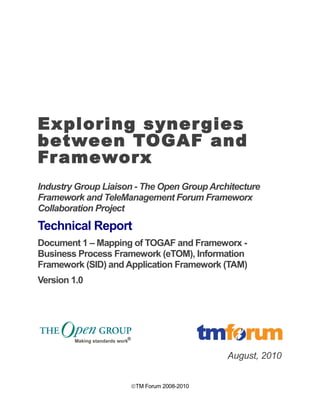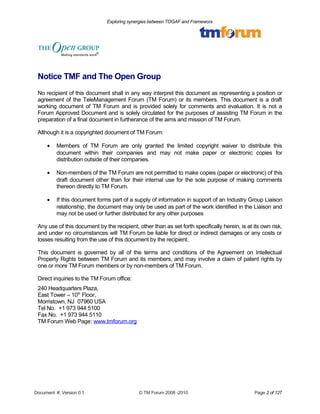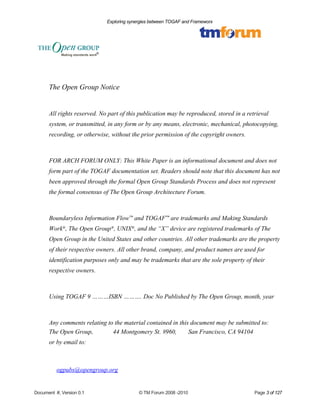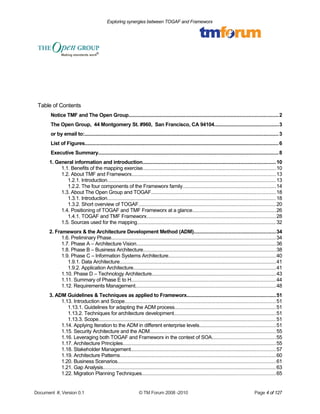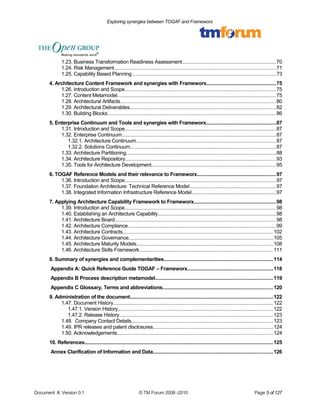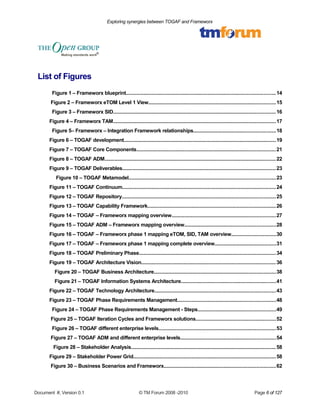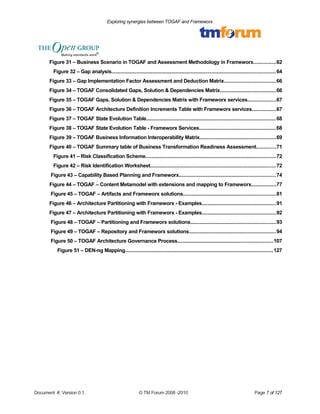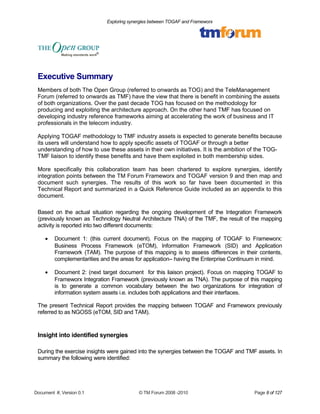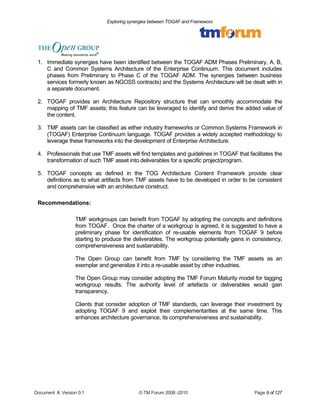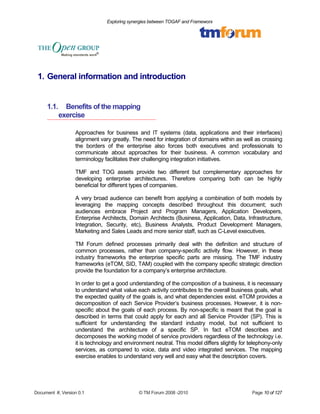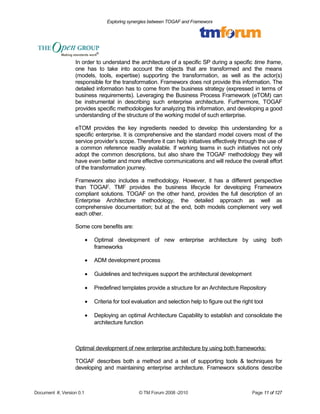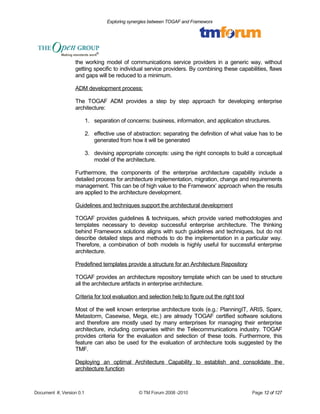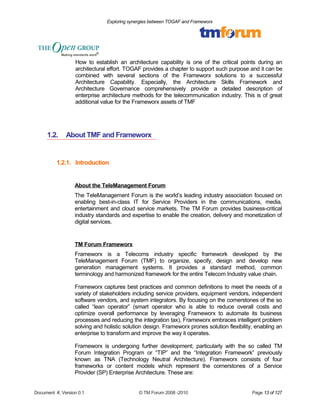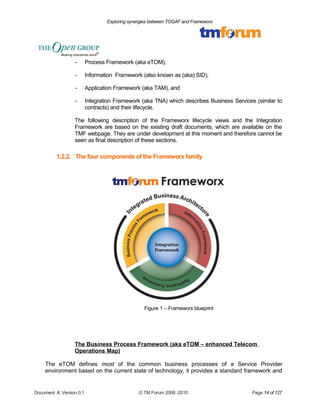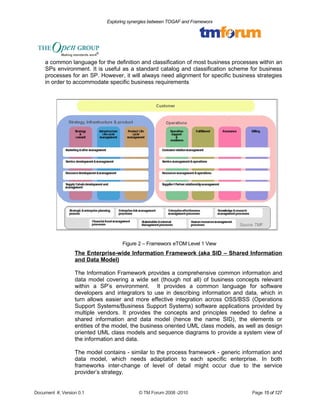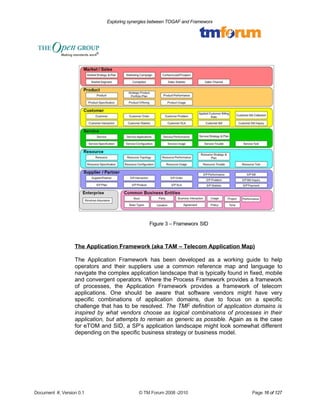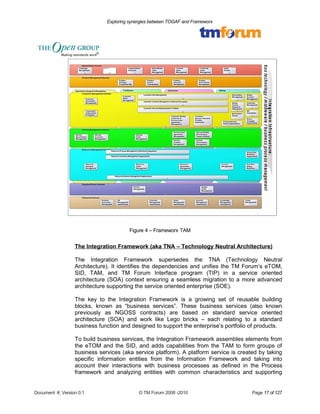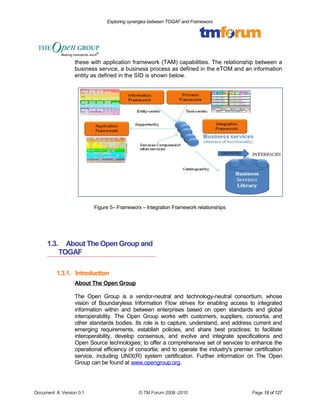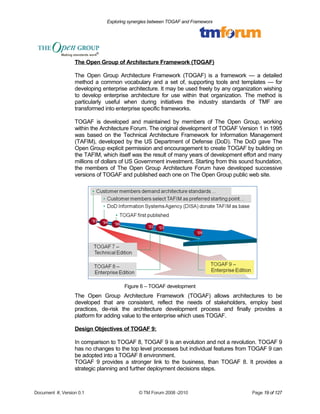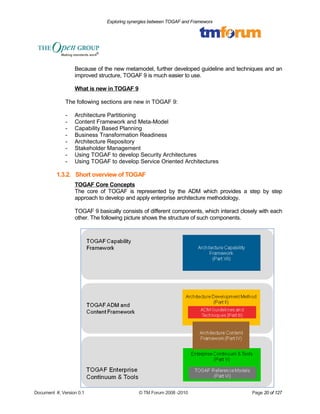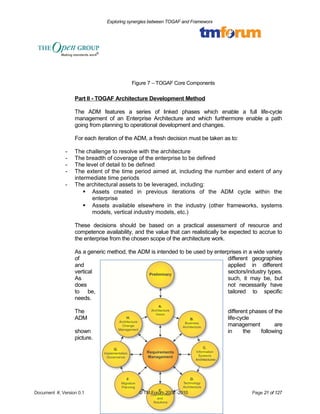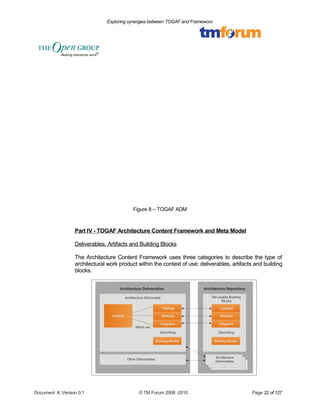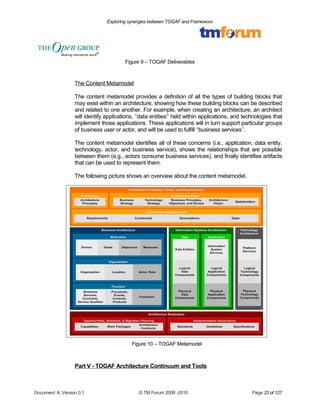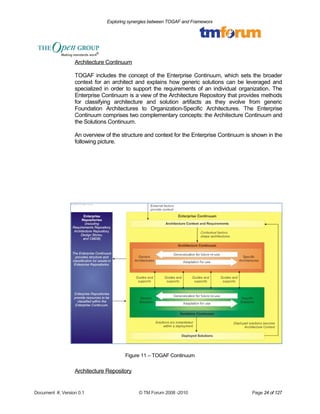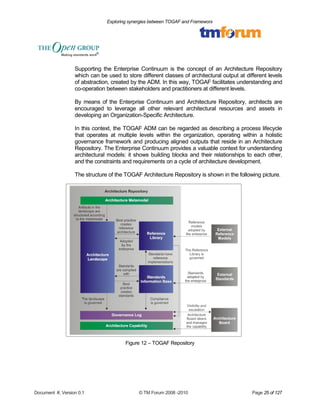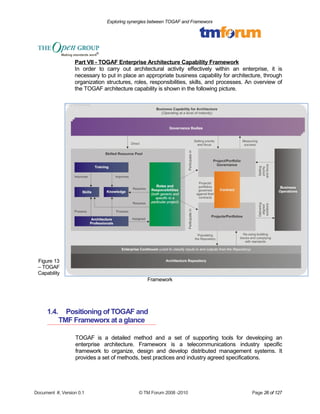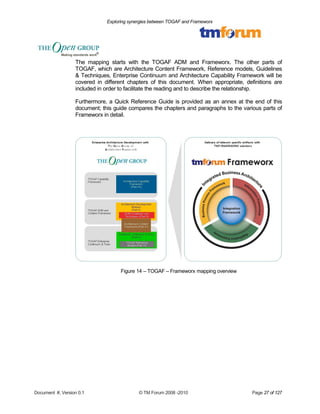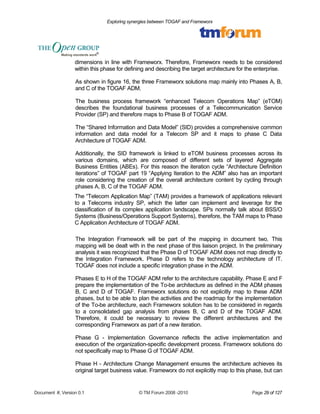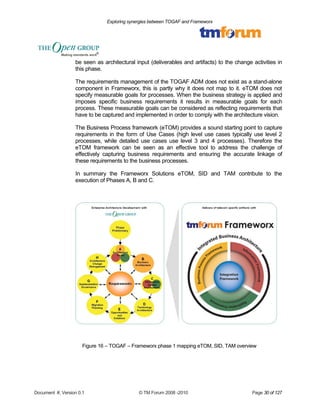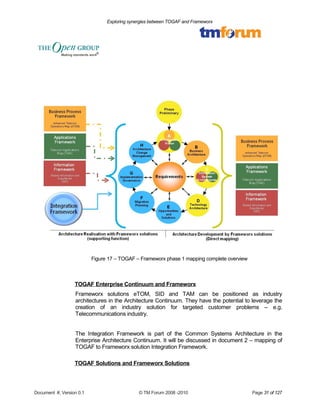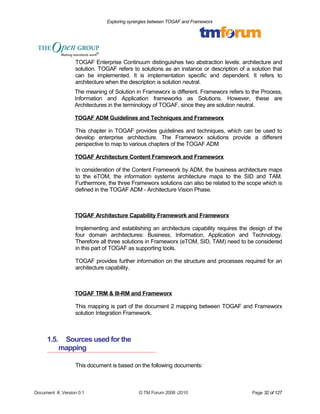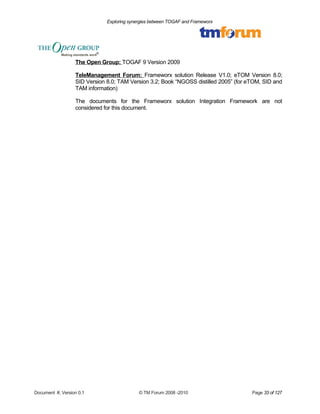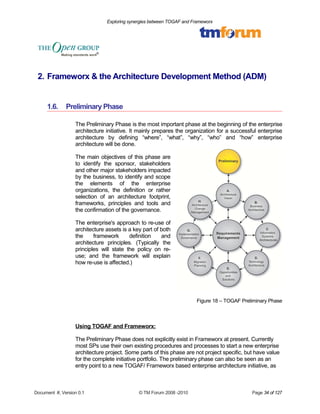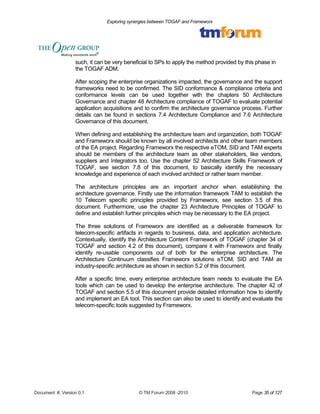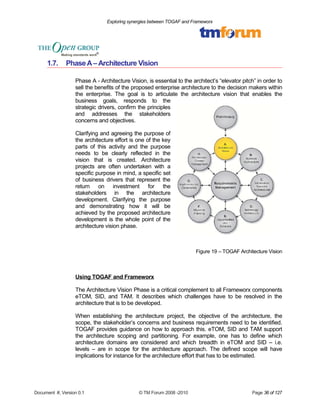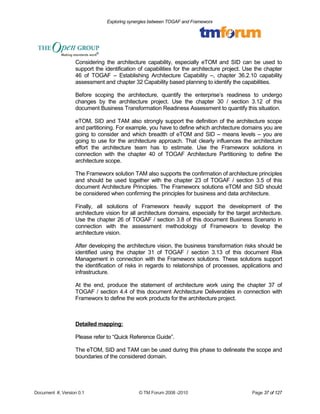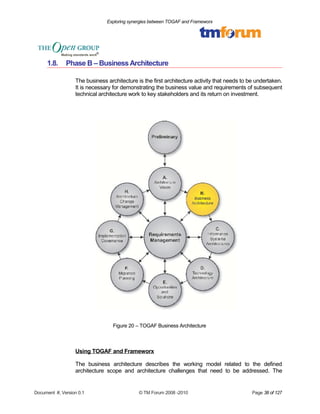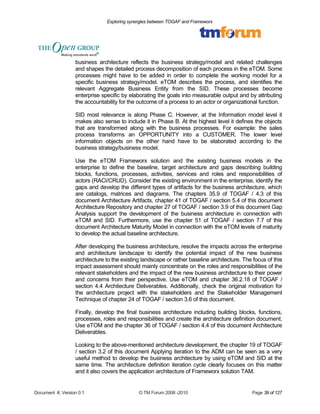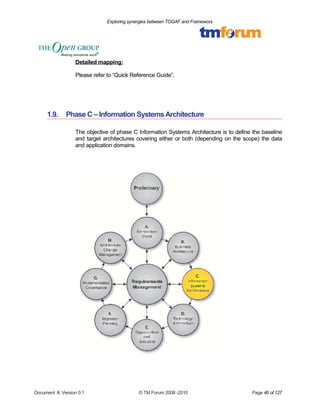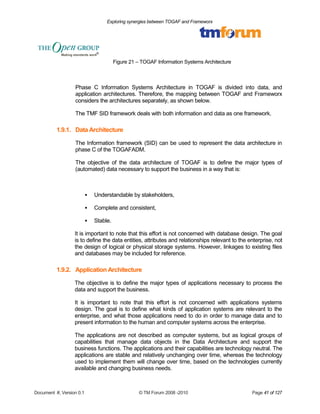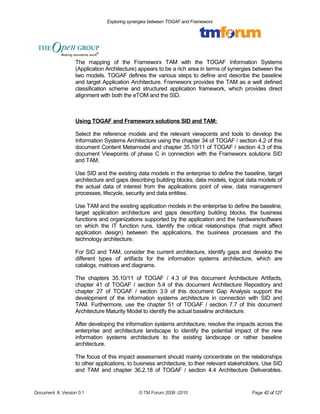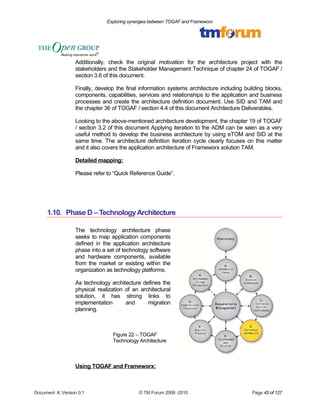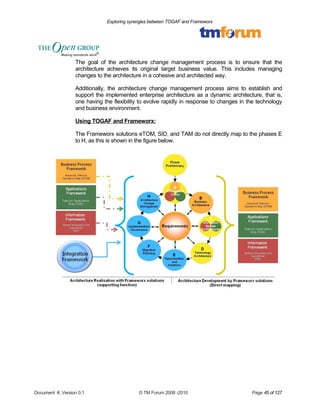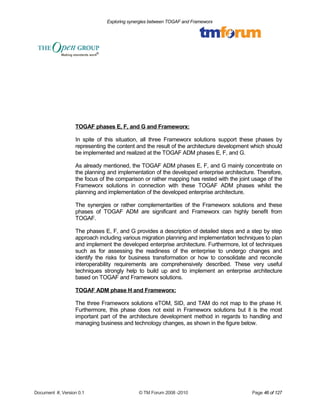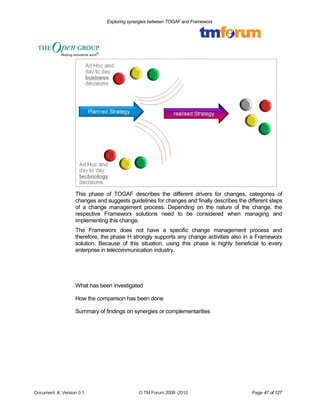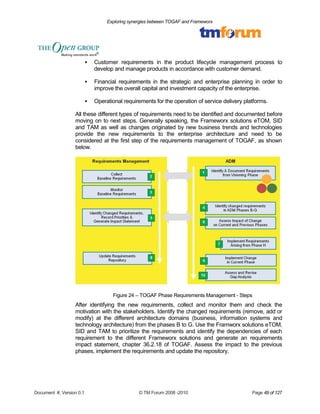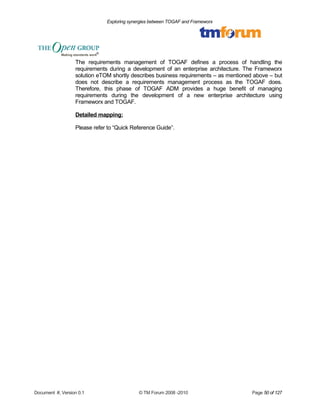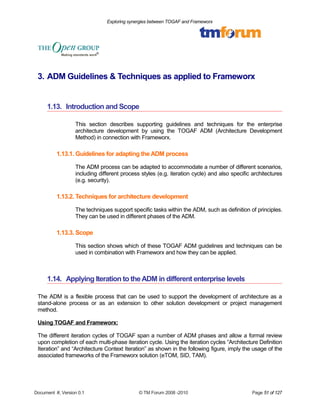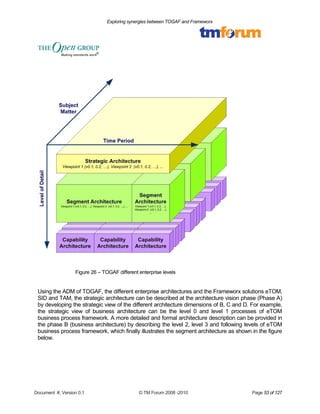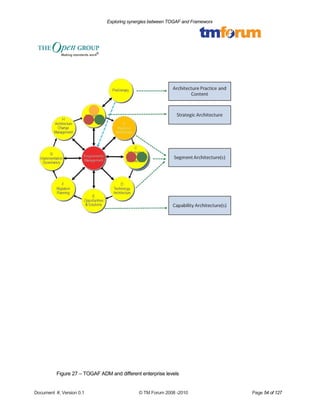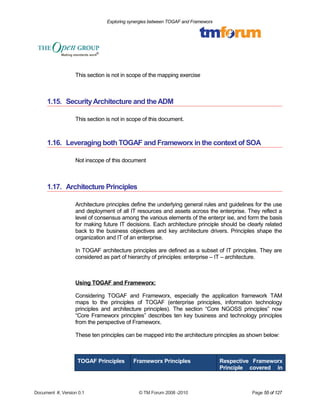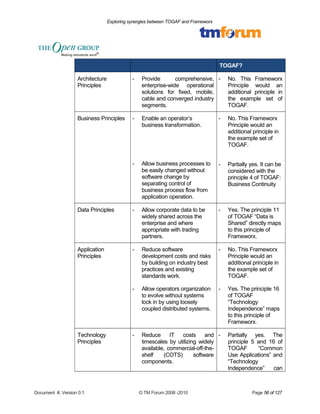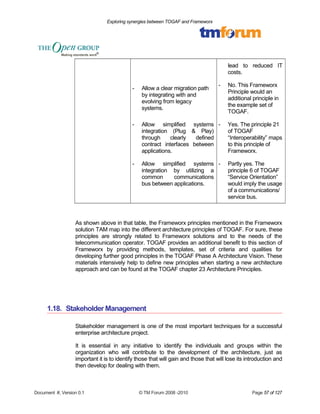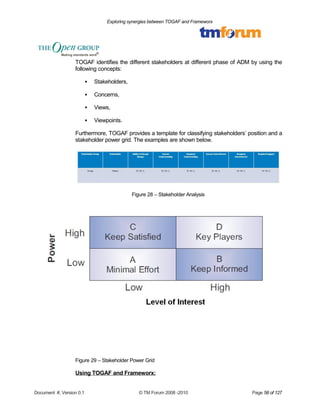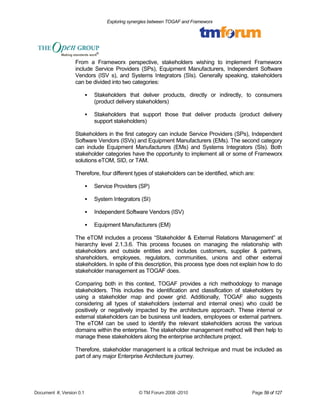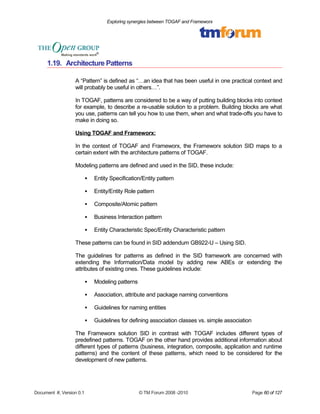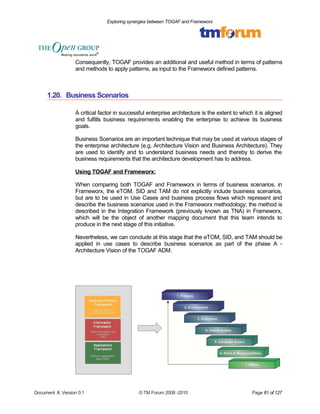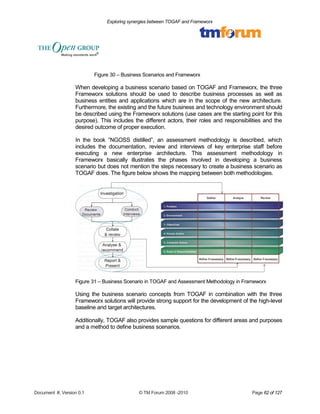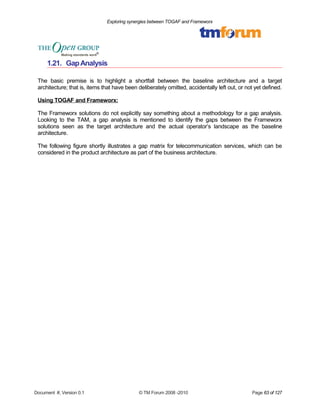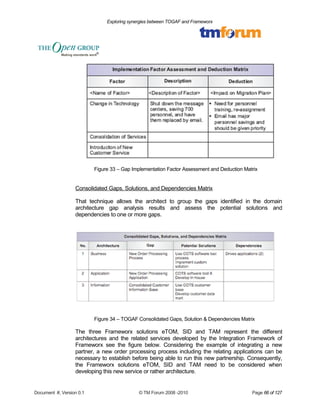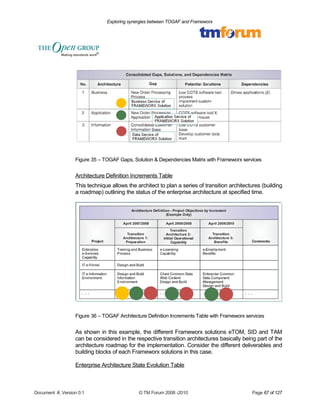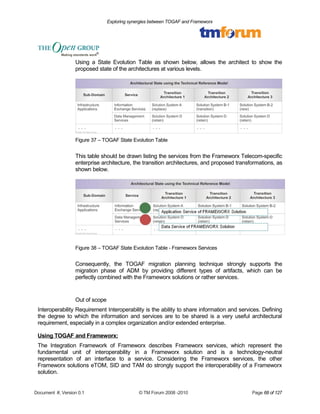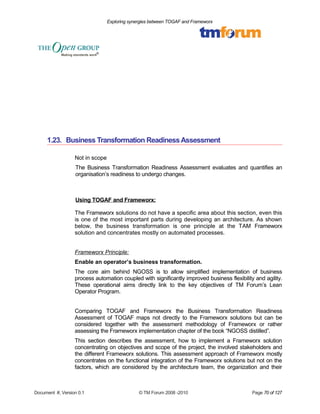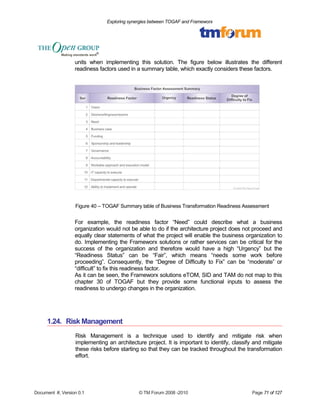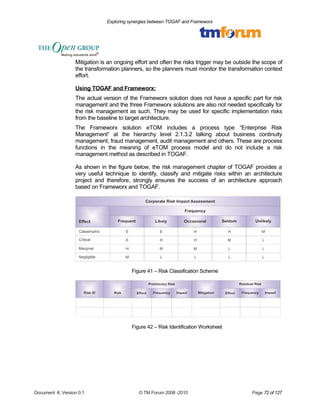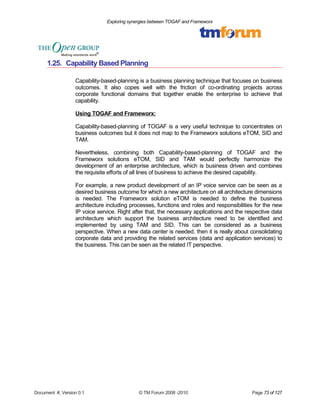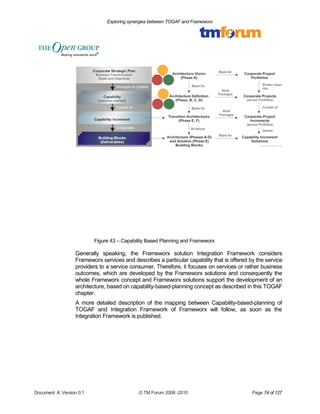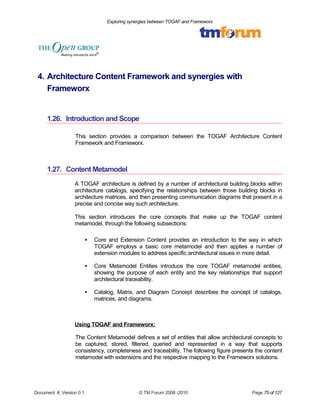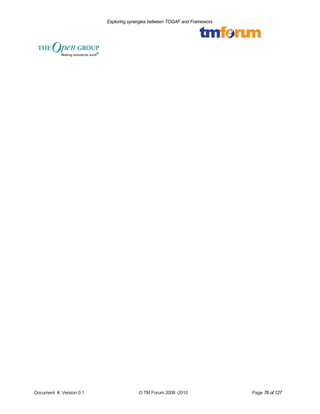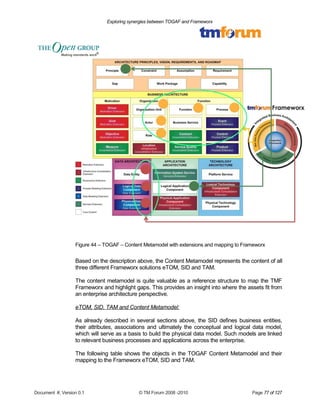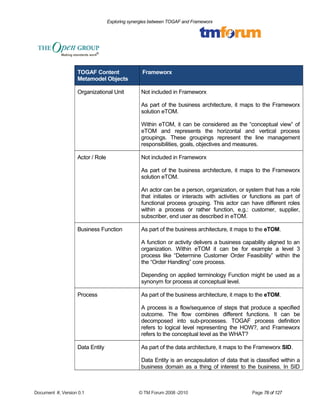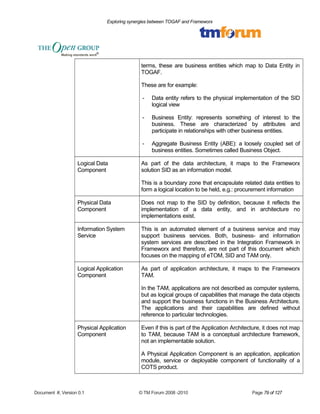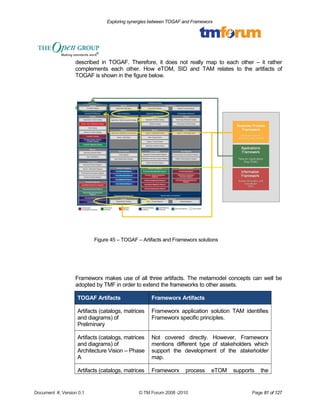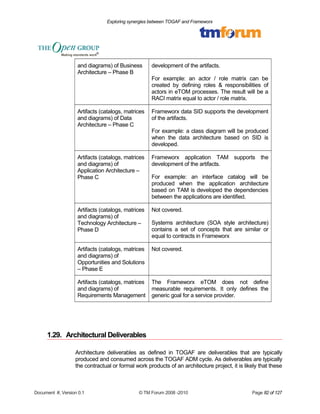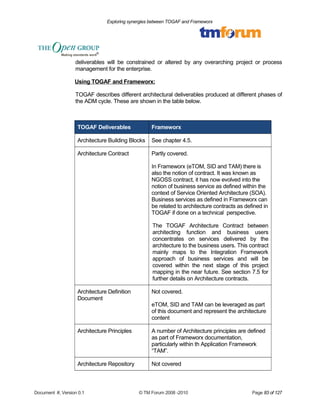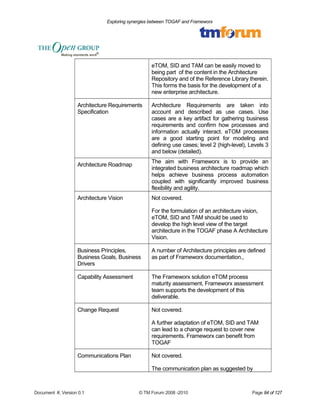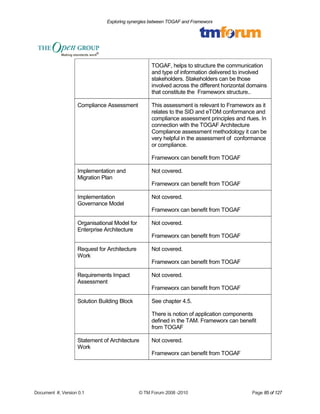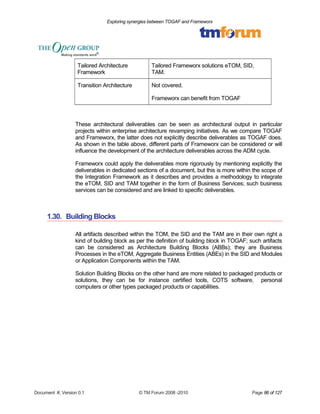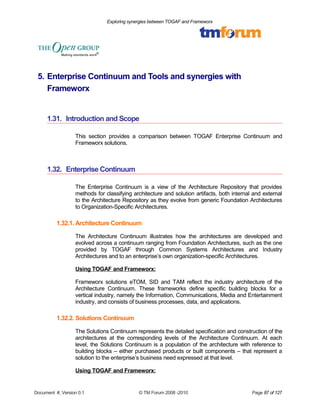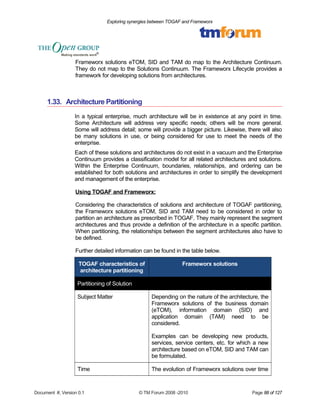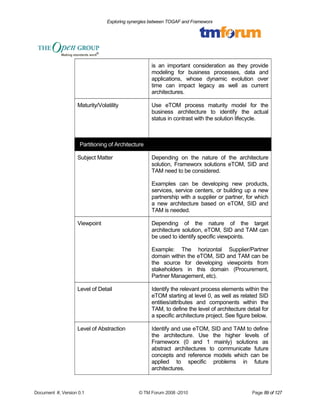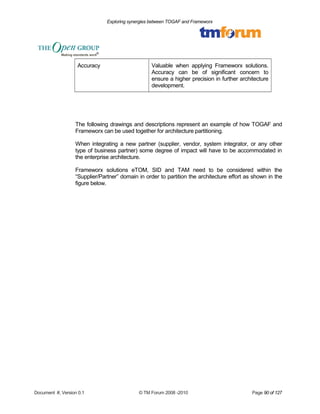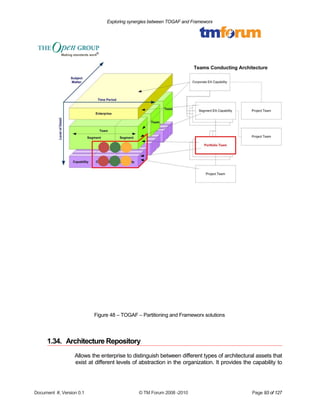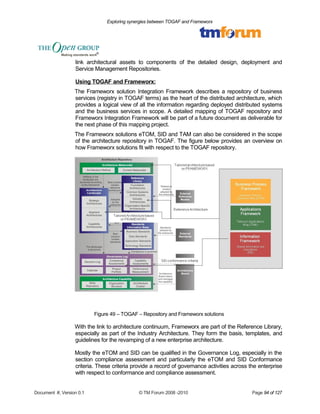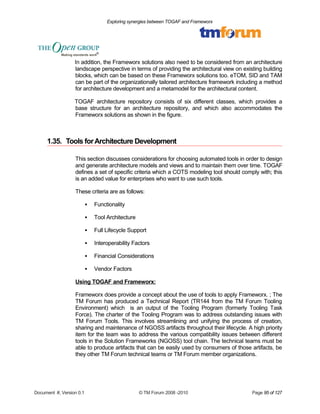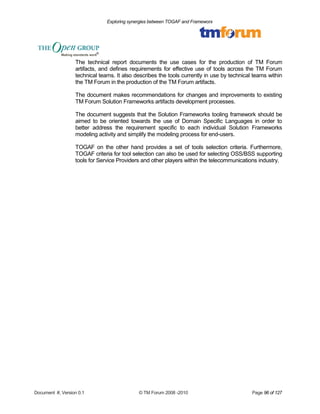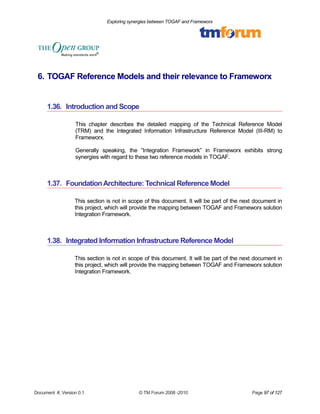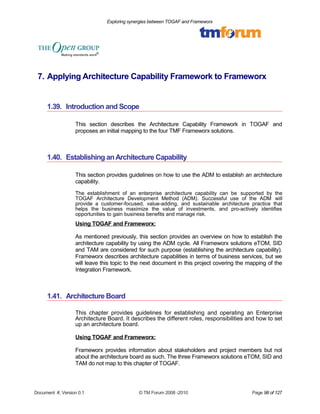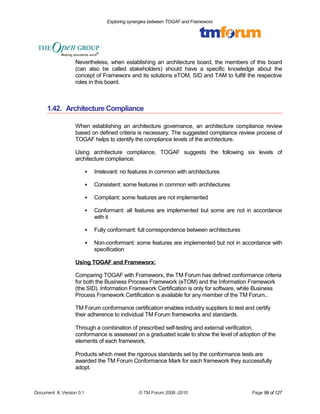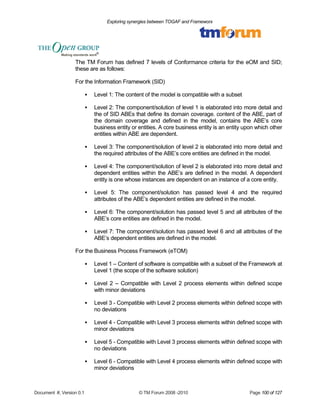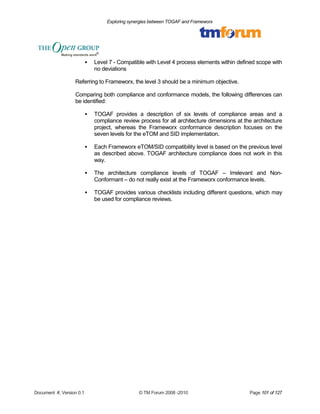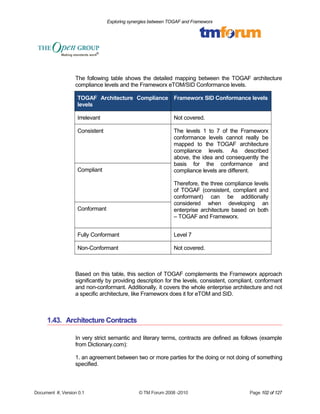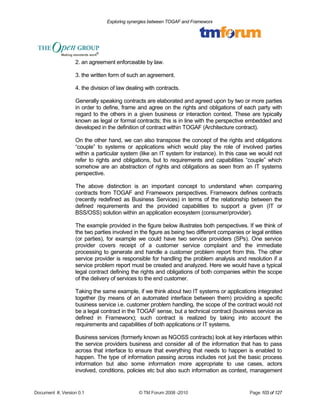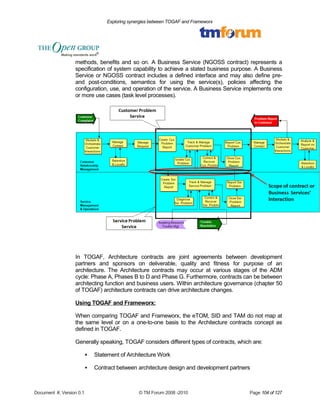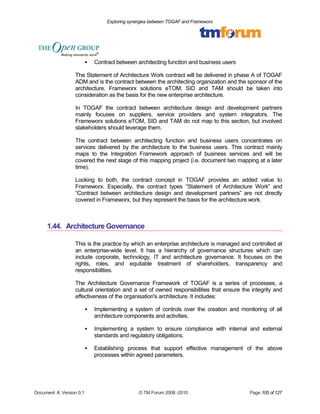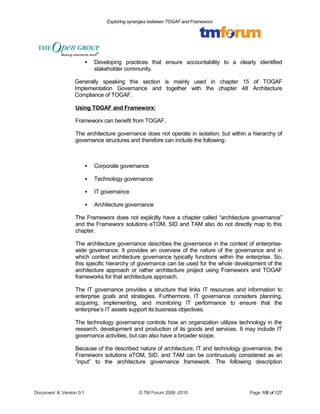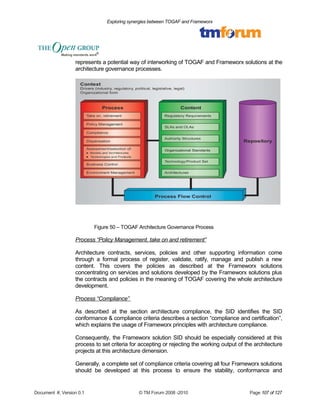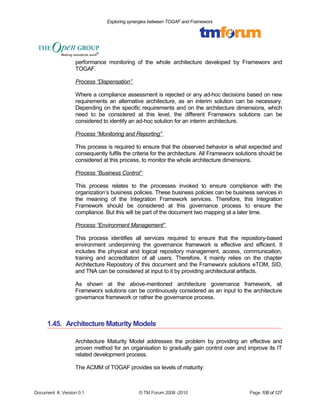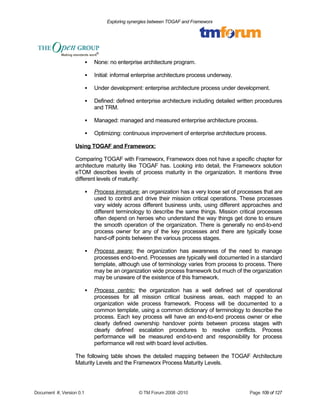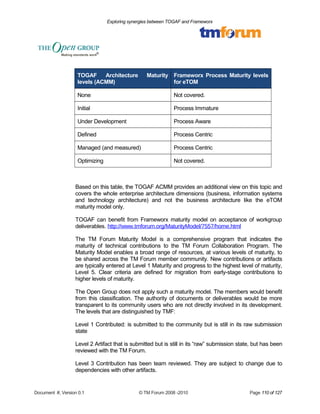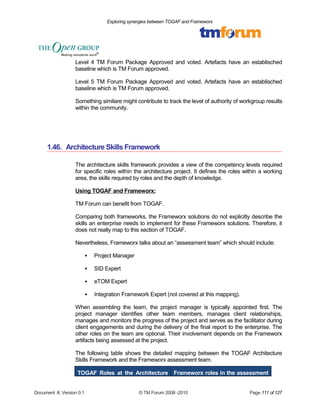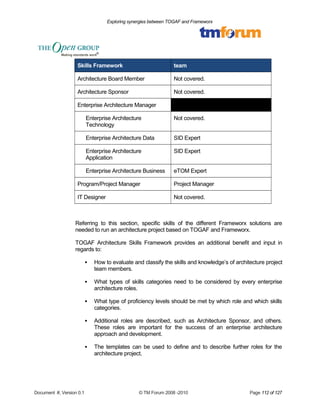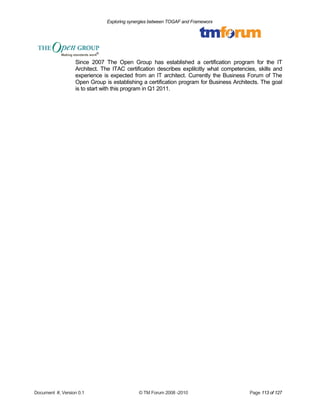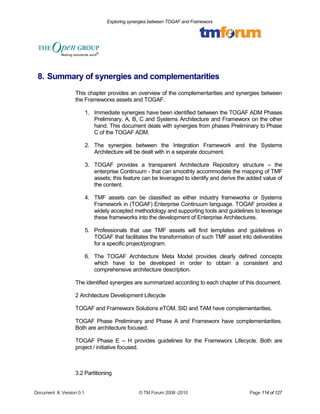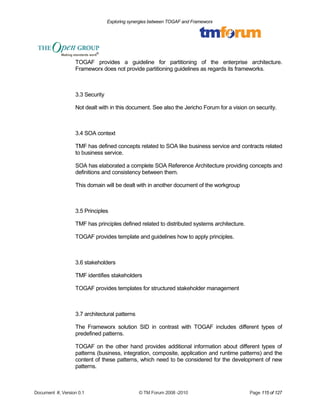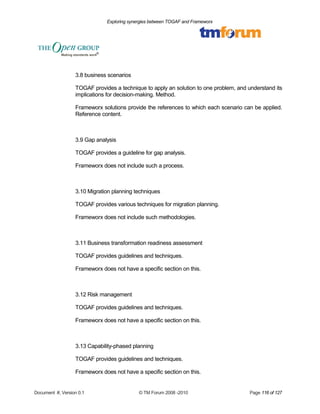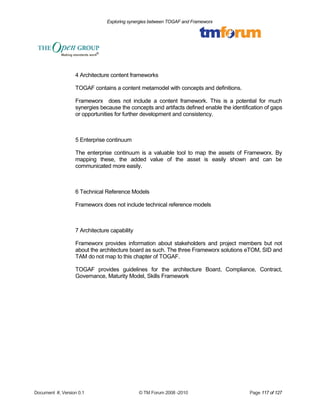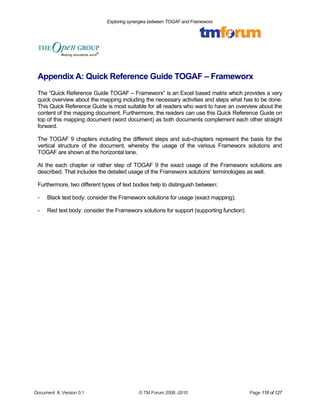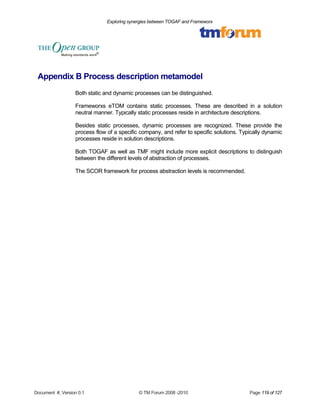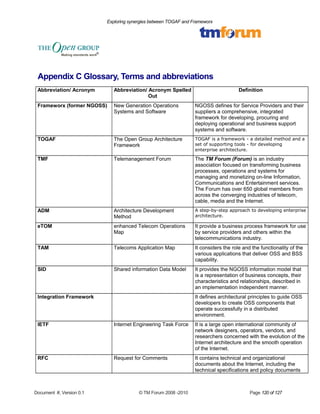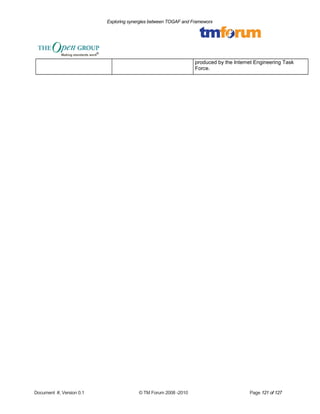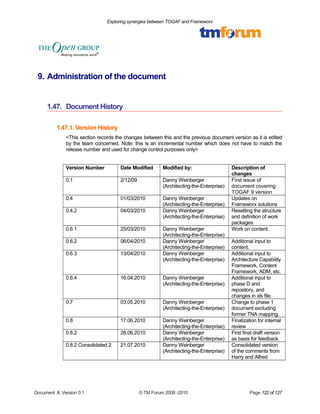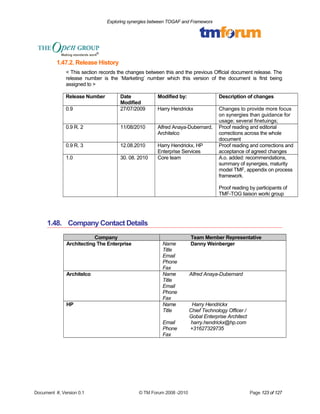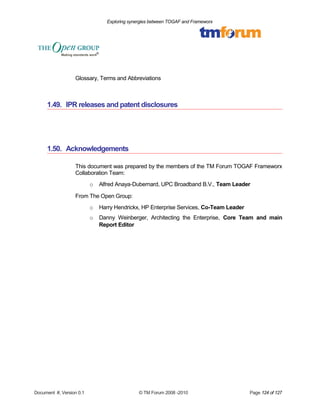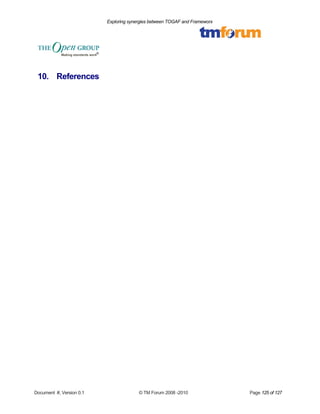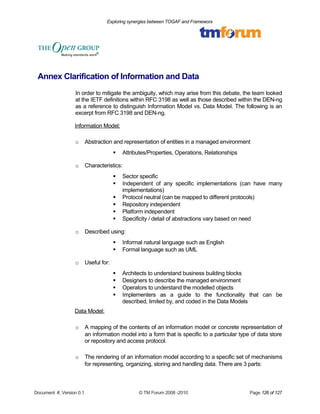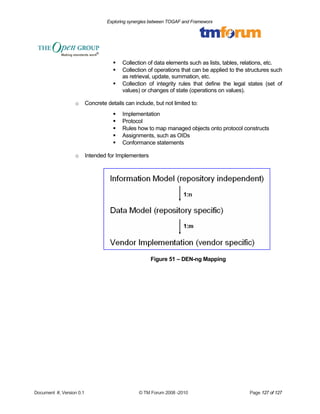TOGAF Vs E-Tom
- 1. Exploring synergies between TOGAF and Frameworx Industry Group Liaison - The Open Group Architecture Framework and TeleManagement Forum Frameworx Collaboration Project Technical Report Document 1 – Mapping of TOGAF and Frameworx - Business Process Framework (eTOM), Information Framework (SID) and Application Framework (TAM) Version 1.0 August, 2010 ãTM Forum 2008-2010
- 2. Exploring synergies between TOGAF and Frameworx Notice TMF and The Open Group No recipient of this document shall in any way interpret this document as representing a position or agreement of the TeleManagement Forum (TM Forum) or its members. This document is a draft working document of TM Forum and is provided solely for comments and evaluation. It is not a Forum Approved Document and is solely circulated for the purposes of assisting TM Forum in the preparation of a final document in furtherance of the aims and mission of TM Forum. Although it is a copyrighted document of TM Forum: · Members of TM Forum are only granted the limited copyright waiver to distribute this document within their companies and may not make paper or electronic copies for distribution outside of their companies. · Non-members of the TM Forum are not permitted to make copies (paper or electronic) of this draft document other than for their internal use for the sole purpose of making comments thereon directly to TM Forum. · If this document forms part of a supply of information in support of an Industry Group Liaison relationship, the document may only be used as part of the work identified in the Liaison and may not be used or further distributed for any other purposes Any use of this document by the recipient, other than as set forth specifically herein, is at its own risk, and under no circumstances will TM Forum be liable for direct or indirect damages or any costs or losses resulting from the use of this document by the recipient. This document is governed by all of the terms and conditions of the Agreement on Intellectual Property Rights between TM Forum and its members, and may involve a claim of patent rights by one or more TM Forum members or by non-members of TM Forum. Direct inquiries to the TM Forum office: 240 Headquarters Plaza, East Tower – 10th Floor, Morristown, NJ 07960 USA Tel No. +1 973 944 5100 Fax No. +1 973 944 5110 TM Forum Web Page: www.tmforum.org Document #, Version 0.1 © TM Forum 2008 -2010 Page 2 of 127
- 3. Exploring synergies between TOGAF and Frameworx The Open Group Notice All rights reserved. No part of this publication may be reproduced, stored in a retrieval system, or transmitted, in any form or by any means, electronic, mechanical, photocopying, recording, or otherwise, without the prior permission of the copyright owners. FOR ARCH FORUM ONLY: This White Paper is an informational document and does not form part of the TOGAF documentation set. Readers should note that this document has not been approved through the formal Open Group Standards Process and does not represent the formal consensus of The Open Group Architecture Forum. Boundaryless Information Flow™ and TOGAF™ are trademarks and Making Standards Work®, The Open Group®, UNIX®, and the “X” device are registered trademarks of The Open Group in the United States and other countries. All other trademarks are the property of their respective owners. All other brand, company, and product names are used for identification purposes only and may be trademarks that are the sole property of their respective owners. Using TOGAF 9 ………ISBN ………. Doc No Published by The Open Group, month, year Any comments relating to the material contained in this document may be submitted to: The Open Group, 44 Montgomery St. #960, San Francisco, CA 94104 or by email to: ogpubs@opengroup.org Document #, Version 0.1 © TM Forum 2008 -2010 Page 3 of 127
- 4. Exploring synergies between TOGAF and Frameworx Table of Contents Notice TMF and The Open Group......................................................................................................2 The Open Group, 44 Montgomery St. #960, San Francisco, CA 94104............................................3 or by email to:.................................................................................................................................... 3 List of Figures.................................................................................................................................... 6 Executive Summary...........................................................................................................................8 1. General information and introduction...........................................................................................10 1.1. Benefits of the mapping exercise...........................................................................................10 1.2. About TMF and Frameworx..................................................................................................13 1.2.1. Introduction...................................................................................................................13 1.2.2. The four components of the Frameworx family................................................................14 1.3. About The Open Group and TOGAF.....................................................................................18 1.3.1. Introduction...................................................................................................................18 1.3.2. Short overview of TOGAF..............................................................................................20 1.4. Positioning of TOGAF and TMF Frameworx at a glance.........................................................26 1.4.1. TOGAF and TMF Frameworx........................................................................................28 1.5. Sources used for the mapping...............................................................................................32 2. Frameworx & the Architecture Development Method (ADM)........................................................34 1.6. Preliminary Phase................................................................................................................34 1.7. Phase A – Architecture Vision...............................................................................................36 1.8. Phase B – Business Architecture...........................................................................................38 1.9. Phase C – Information Systems Architecture.........................................................................40 1.9.1. Data Architecture...........................................................................................................41 1.9.2. Application Architecture.................................................................................................41 1.10. Phase D – Technology Architecture.....................................................................................43 1.11. Summary of Phase E to H...................................................................................................44 1.12. Requirements Management................................................................................................48 3. ADM Guidelines & Techniques as applied to Frameworx.............................................................51 1.13. Introduction and Scope.......................................................................................................51 1.13.1. Guidelines for adapting the ADM process.....................................................................51 1.13.2. Techniques for architecture development......................................................................51 1.13.3. Scope.........................................................................................................................51 1.14. Applying Iteration to the ADM in different enterprise levels....................................................51 1.15. Security Architecture and the ADM......................................................................................55 1.16. Leveraging both TOGAF and Frameworx in the context of SOA............................................55 1.17. Architecture Principles........................................................................................................55 1.18. Stakeholder Management...................................................................................................57 1.19. Architecture Patterns..........................................................................................................60 1.20. Business Scenarios............................................................................................................61 1.21. Gap Analysis......................................................................................................................63 1.22. Migration Planning Techniques...........................................................................................65 Document #, Version 0.1 © TM Forum 2008 -2010 Page 4 of 127
- 5. Exploring synergies between TOGAF and Frameworx 1.23. Business Transformation Readiness Assessment................................................................70 1.24. Risk Management..............................................................................................................71 1.25. Capability Based Planning..................................................................................................73 4. Architecture Content Framework and synergies with Frameworx...............................................75 1.26. Introduction and Scope.......................................................................................................75 1.27. Content Metamodel............................................................................................................75 1.28. Architectural Artifacts..........................................................................................................80 1.29. Architectural Deliverables....................................................................................................82 1.30. Building Blocks...................................................................................................................86 5. Enterprise Continuum and Tools and synergies with Frameworx................................................87 1.31. Introduction and Scope.......................................................................................................87 1.32. Enterprise Continuum.........................................................................................................87 1.32.1. Architecture Continuum...............................................................................................87 1.32.2. Solutions Continuum...................................................................................................87 1.33. Architecture Partitioning......................................................................................................88 1.34. Architecture Repository.......................................................................................................93 1.35. Tools for Architecture Development.....................................................................................95 6. TOGAF Reference Models and their relevance to Frameworx......................................................97 1.36. Introduction and Scope.......................................................................................................97 1.37. Foundation Architecture: Technical Reference Model...........................................................97 1.38. Integrated Information Infrastructure Reference Model..........................................................97 7. Applying Architecture Capability Framework to Frameworx........................................................98 1.39. Introduction and Scope.......................................................................................................98 1.40. Establishing an Architecture Capability................................................................................98 1.41. Architecture Board..............................................................................................................98 1.42. Architecture Compliance.....................................................................................................99 1.43. Architecture Contracts.......................................................................................................102 1.44. Architecture Governance...................................................................................................105 1.45. Architecture Maturity Models.............................................................................................108 1.46. Architecture Skills Framework...........................................................................................111 8. Summary of synergies and complementarities...........................................................................114 Appendix A: Quick Reference Guide TOGAF – Frameworx..........................................................118 Appendix B Process description metamodel................................................................................119 Appendix C Glossary, Terms and abbreviations...........................................................................120 9. Administration of the document..................................................................................................122 1.47. Document History.............................................................................................................122 1.47.1. Version History..........................................................................................................122 1.47.2. Release History.........................................................................................................123 1.48. Company Contact Details.................................................................................................123 1.49. IPR releases and patent disclosures..................................................................................124 1.50. Acknowledgements..........................................................................................................124 10. References.................................................................................................................................125 Annex Clarification of Information and Data..................................................................................126 Document #, Version 0.1 © TM Forum 2008 -2010 Page 5 of 127
- 6. Exploring synergies between TOGAF and Frameworx List of Figures Figure 1 – Frameworx blueprint......................................................................................................14 Figure 2 – Frameworx eTOM Level 1 View.......................................................................................15 Figure 3 – Frameworx SID...............................................................................................................16 Figure 4 – Frameworx TAM...............................................................................................................17 Figure 5– Frameworx – Integration Framework relationships........................................................18 Figure 6 – TOGAF development........................................................................................................19 Figure 7 – TOGAF Core Components...............................................................................................21 Figure 8 – TOGAF ADM.....................................................................................................................22 Figure 9 – TOGAF Deliverables.........................................................................................................23 Figure 10 – TOGAF Metamodel....................................................................................................23 Figure 11 – TOGAF Continuum.........................................................................................................24 Figure 12 – TOGAF Repository.........................................................................................................25 Figure 13 – TOGAF Capability Framework........................................................................................26 Figure 14 – TOGAF – Frameworx mapping overview.......................................................................27 Figure 15 – TOGAF ADM – Frameworx mapping overview..............................................................28 Figure 16 – TOGAF – Frameworx phase 1 mapping eTOM, SID, TAM overview..............................30 Figure 17 – TOGAF – Frameworx phase 1 mapping complete overview..........................................31 Figure 18 – TOGAF Preliminary Phase.............................................................................................34 Figure 19 – TOGAF Architecture Vision............................................................................................36 Figure 20 – TOGAF Business Architecture...................................................................................38 Figure 21 – TOGAF Information Systems Architecture.................................................................41 Figure 22 – TOGAF Technology Architecture...................................................................................43 Figure 23 – TOGAF Phase Requirements Management...................................................................48 Figure 24 – TOGAF Phase Requirements Management - Steps.....................................................49 Figure 25 – TOGAF Iteration Cycles and Frameworx solutions.......................................................52 Figure 26 – TOGAF different enterprise levels................................................................................53 Figure 27 – TOGAF ADM and different enterprise levels.................................................................54 Figure 28 – Stakeholder Analysis...................................................................................................58 Figure 29 – Stakeholder Power Grid.................................................................................................58 Figure 30 – Business Scenarios and Frameworx............................................................................62 Document #, Version 0.1 © TM Forum 2008 -2010 Page 6 of 127
- 7. Exploring synergies between TOGAF and Frameworx Figure 31 – Business Scenario in TOGAF and Assessment Methodology in Frameworx...............62 Figure 32 – Gap analysis................................................................................................................64 Figure 33 – Gap Implementation Factor Assessment and Deduction Matrix...................................66 Figure 34 – TOGAF Consolidated Gaps, Solution & Dependencies Matrix......................................66 Figure 35 – TOGAF Gaps, Solution & Dependencies Matrix with Frameworx services...................67 Figure 36 – TOGAF Architecture Definition Increments Table with Frameworx services................67 Figure 37 – TOGAF State Evolution Table........................................................................................68 Figure 38 – TOGAF State Evolution Table - Frameworx Services....................................................68 Figure 39 – TOGAF Business Information Interoperability Matrix....................................................69 Figure 40 – TOGAF Summary table of Business Transformation Readiness Assessment.............71 Figure 41 – Risk Classification Scheme.........................................................................................72 Figure 42 – Risk Identification Worksheet......................................................................................72 Figure 43 – Capability Based Planning and Frameworx..................................................................74 Figure 44 – TOGAF – Content Metamodel with extensions and mapping to Frameworx.................77 Figure 45 – TOGAF – Artifacts and Frameworx solutions...............................................................81 Figure 46 – Architecture Partitioning with Frameworx - Examples..................................................91 Figure 47 – Architecture Partitioning with Frameworx - Examples..................................................92 Figure 48 – TOGAF – Partitioning and Frameworx solutions..........................................................93 Figure 49 – TOGAF – Repository and Frameworx solutions...........................................................94 Figure 50 – TOGAF Architecture Governance Process.................................................................107 Figure 51 – DEN-ng Mapping.....................................................................................................127 Document #, Version 0.1 © TM Forum 2008 -2010 Page 7 of 127
- 8. Exploring synergies between TOGAF and Frameworx Executive Summary Members of both The Open Group (referred to onwards as TOG) and the TeleManagement Forum (referred to onwards as TMF) have the view that there is benefit in combining the assets of both organizations. Over the past decade TOG has focused on the methodology for producing and exploiting the architecture approach. On the other hand TMF has focused on developing industry reference frameworks aiming at accelerating the work of business and IT professionals in the telecom industry. Applying TOGAF methodology to TMF industry assets is expected to generate benefits because its users will understand how to apply specific assets of TOGAF or through a better understanding of how to use these assets in their own initiatives. It is the ambition of the TOG-TMF liaison to identify these benefits and have them exploited in both membership sides. More specifically this collaboration team has been chartered to explore synergies, identify integration points between the TM Forum Frameworx and TOGAF version 9 and then map and document such synergies. The results of this work so far have been documented in this Technical Report and summarized in a Quick Reference Guide included as an appendix to this document. Based on the actual situation regarding the ongoing development of the Integration Framework (previously known as Technology Neutral Architecture TNA) of the TMF, the result of the mapping activity is reported into two different documents: · Document 1: (this current document). Focus on the mapping of TOGAF to Frameworx: Business Process Framework (eTOM), Information Framework (SID) and Application Framework (TAM). The purpose of this mapping is to assess differences in their contents, complementarities and the areas for application– having the Enterprise Continuum in mind. · Document 2: (next target document for this liaison project). Focus on mapping TOGAF to Frameworx Integration Framework (previously known as TNA). The purpose of this mapping is to generate a common vocabulary between the two organizations for integration of information system assets i.e. includes both applications and their interfaces. The present Technical Report provides the mapping between TOGAF and Frameworx previously referred to as NGOSS (eTOM, SID and TAM). Insight into identified synergies During the exercise insights were gained into the synergies between the TOGAF and TMF assets. In summary the following were identified: Document #, Version 0.1 © TM Forum 2008 -2010 Page 8 of 127
- 9. Exploring synergies between TOGAF and Frameworx 1. Immediate synergies have been identified between the TOGAF ADM Phases Preliminary, A, B, C and Common Systems Architecture of the Enterprise Continuum. This document includes phases from Preliminary to Phase C of the TOGAF ADM. The synergies between business services formerly known as NGOSS contracts) and the Systems Architecture will be dealt with in a separate document. 2. TOGAF provides an Architecture Repository structure that can smoothly accommodate the mapping of TMF assets; this feature can be leveraged to identify and derive the added value of the content. 3. TMF assets can be classified as either industry frameworks or Common Systems Framework in (TOGAF) Enterprise Continuum language. TOGAF provides a widely accepted methodology to leverage these frameworks into the development of Enterprise Architecture. 4. Professionals that use TMF assets will find templates and guidelines in TOGAF that facilitates the transformation of such TMF asset into deliverables for a specific project/program. 5. TOGAF concepts as defined in the TOG Architecture Content Framework provide clear definitions as to what artifacts from TMF assets have to be developed in order to be consistent and comprehensive with an architecture construct. Recommendations: TMF workgroups can benefit from TOGAF by adopting the concepts and definitions from TOGAF. Once the charter of a workgroup is agreed, it is suggested to have a preliminary phase for identification of re-usable elements from TOGAF 9 before starting to produce the deliverables. The workgroup potentially gains in consistency, comprehensiveness and sustainability. The Open Group can benefit from TMF by considering the TMF assets as an exemplar and generalize it into a re-usable asset by other industries. The Open Group may consider adopting the TMF Forum Maturity model for tagging workgroup results. The authority level of artefacts or deliverables would gain transparency. Clients that consider adoption of TMF standards, can leverage their investment by adopting TOGAF 9 and exploit their complementarities at the same time. This enhances architecture governance, its comprehensiveness and sustainability. Document #, Version 0.1 © TM Forum 2008 -2010 Page 9 of 127
- 10. Exploring synergies between TOGAF and Frameworx 1. General information and introduction 1.1. Benefits of the mapping exercise Approaches for business and IT systems (data, applications and their interfaces) alignment vary greatly. The need for integration of domains within as well as crossing the borders of the enterprise also forces both executives and professionals to communicate about approaches for their business. A common vocabulary and terminology facilitates their challenging integration initiatives. TMF and TOG assets provide two different but complementary approaches for developing enterprise architectures. Therefore comparing both can be highly beneficial for different types of companies. A very broad audience can benefit from applying a combination of both models by leveraging the mapping concepts described throughout this document; such audiences embrace Project and Program Managers, Application Developers, Enterprise Architects, Domain Architects (Business, Application, Data, Infrastructure, Integration, Security, etc), Business Analysts, Product Development Managers, Marketing and Sales Leads and more senior staff, such as C-Level executives. TM Forum defined processes primarily deal with the definition and structure of common processes, rather than company-specific activity flow. However, in these industry frameworks the enterprise specific parts are missing. The TMF industry frameworks (eTOM, SID, TAM) coupled with the company specific strategic direction provide the foundation for a company’s enterprise architecture. In order to get a good understanding of the composition of a business, it is necessary to understand what value each activity contributes to the overall business goals, what the expected quality of the goals is, and what dependencies exist. eTOM provides a decomposition of each Service Provider’s business processes. However, it is non-specific about the goals of each process. By non-specific is meant that the goal is described in terms that could apply for each and all Service Provider (SP). This is sufficient for understanding the standard industry model, but not sufficient to understand the architecture of a specific SP. In fact eTOM describes and decomposes the working model of service providers regardless of the technology i.e. it is technology and environment neutral. This model differs slightly for telephony-only services, as compared to voice, data and video integrated services. The mapping exercise enables to understand very well and easy what the description covers. Document #, Version 0.1 © TM Forum 2008 -2010 Page 10 of 127
- 11. Exploring synergies between TOGAF and Frameworx In order to understand the architecture of a specific SP during a specific time frame, one has to take into account the objects that are transformed and the means (models, tools, expertise) supporting the transformation, as well as the actor(s) responsible for the transformation. Frameworx does not provide this information. The detailed information has to come from the business strategy (expressed in terms of business requirements). Leveraging the Business Process Framework (eTOM) can be instrumental in describing such enterprise architecture. Furthermore, TOGAF provides specific methodologies for analyzing this information, and developing a good understanding of the structure of the working model of such enterprise. eTOM provides the key ingredients needed to develop this understanding for a specific enterprise. It is comprehensive and the standard model covers most of the service provider’s scope. Therefore it can help initiatives effectively through the use of a common reference readily available. If working teams in such initiatives not only adopt the common descriptions, but also share the TOGAF methodology they will have even better and more effective communications and will reduce the overall effort of the transformation journey. Frameworx also includes a methodology. However, it has a different perspective than TOGAF. TMF provides the business lifecycle for developing Frameworx compliant solutions. TOGAF on the other hand, provides the full description of an Enterprise Architecture methodology, the detailed approach as well as comprehensive documentation; but at the end, both models complement very well each other. Some core benefits are: · Optimal development of new enterprise architecture by using both frameworks · ADM development process · Guidelines and techniques support the architectural development · Predefined templates provide a structure for an Architecture Repository · Criteria for tool evaluation and selection help to figure out the right tool · Deploying an optimal Architecture Capability to establish and consolidate the architecture function Optimal development of new enterprise architecture by using both frameworks: TOGAF describes both a method and a set of supporting tools & techniques for developing and maintaining enterprise architecture. Frameworx solutions describe Document #, Version 0.1 © TM Forum 2008 -2010 Page 11 of 127
- 12. Exploring synergies between TOGAF and Frameworx the working model of communications service providers in a generic way, without getting specific to individual service providers. By combining these capabilities, flaws and gaps will be reduced to a minimum. ADM development process: The TOGAF ADM provides a step by step approach for developing enterprise architecture: 1. separation of concerns: business, information, and application structures. 2. effective use of abstraction: separating the definition of what value has to be generated from how it will be generated 3. devising appropriate concepts: using the right concepts to build a conceptual model of the architecture. Furthermore, the components of the enterprise architecture capability include a detailed process for architecture implementation, migration, change and requirements management. This can be of high value to the Frameworx’ approach when the results are applied to the architecture development. Guidelines and techniques support the architectural development TOGAF provides guidelines & techniques, which provide varied methodologies and templates necessary to develop successful enterprise architecture. The thinking behind Frameworx solutions aligns with such guidelines and techniques, but do not describe detailed steps and methods to do the implementation in a particular way. Therefore, a combination of both models is highly useful for successful enterprise architecture. Predefined templates provide a structure for an Architecture Repository TOGAF provides an architecture repository template which can be used to structure all the architecture artifacts in enterprise architecture. Criteria for tool evaluation and selection help to figure out the right tool Most of the well known enterprise architecture tools (e.g.: PlanningIT, ARIS, Sparx, Metastorm, Casewise, Mega, etc.) are already TOGAF certified software solutions and therefore are mostly used by many enterprises for managing their enterprise architecture, including companies within the Telecommunications industry. TOGAF provides criteria for the evaluation and selection of these tools. Furthermore, this feature can also be used for the evaluation of architecture tools suggested by the TMF. Deploying an optimal Architecture Capability to establish and consolidate the architecture function Document #, Version 0.1 © TM Forum 2008 -2010 Page 12 of 127
- 13. Exploring synergies between TOGAF and Frameworx How to establish an architecture capability is one of the critical points during an architectural effort. TOGAF provides a chapter to support such purpose and it can be combined with several sections of the Frameworx solutions to a successful Architecture Capability. Especially, the Architecture Skills Framework and Architecture Governance comprehensively provide a detailed description of enterprise architecture methods for the telecommunication industry. This is of great additional value for the Frameworx assets of TMF 1.2. About TMF and Frameworx 1.2.1. Introduction About the TeleManagement Forum The TeleManagement Forum is the world’s leading industry association focused on enabling best-in-class IT for Service Providers in the communications, media, entertainment and cloud service markets. The TM Forum provides business-critical industry standards and expertise to enable the creation, delivery and monetization of digital services. TM Forum Frameworx Frameworx is a Telecoms industry specific framework developed by the TeleManagement Forum (TMF) to organize, specify, design and develop new generation management systems. It provides a standard method, common terminology and harmonized framework for the entire Telecom Industry value chain. Frameworx captures best practices and common definitions to meet the needs of a variety of stakeholders including service providers, equipment vendors, independent software vendors, and system integrators. By focusing on the cornerstones of the so called “lean operator” (smart operator who is able to reduce overall costs and optimize overall performance by leveraging Frameworx to automate its business processes and reducing the integration tax), Frameworx embraces intelligent problem solving and holistic solution design. Frameworx prones solution flexibility, enabling an enterprise to transform and improve the way it operates. Frameworx is undergoing further development; particularly with the so called TM Forum Integration Program or “TIP” and the “Integration Framework” previously known as TNA (Technology Neutral Architecture). Frameworx consists of four frameworks or content models which represent the cornerstones of a Service Provider (SP) Enterprise Architecture. These are: Document #, Version 0.1 © TM Forum 2008 -2010 Page 13 of 127
- 14. Exploring synergies between TOGAF and Frameworx - Process Framework (aka eTOM), - Information Framework (also known as (aka) SID), - Application Framework (aka TAM), and - Integration Framework (aka TNA) which describes Business Services (similar to contracts) and their lifecycle. The following description of the Frameworx lifecycle views and the Integration Framework are based on the existing draft documents, which are available on the TMF webpage. They are under development at this moment and therefore cannot be seen as final description of these sections. 1.2.2. The four components of the Frameworx family Figure 1 – Frameworx blueprint The Business Process Framework (aka eTOM – enhanced Telecom Operations Map) The eTOM defines most of the common business processes of a Service Provider environment based on the current state of technology, it provides a standard framework and Document #, Version 0.1 © TM Forum 2008 -2010 Page 14 of 127
- 15. Exploring synergies between TOGAF and Frameworx a common language for the definition and classification of most business processes within an SPs environment. It is useful as a standard catalog and classification scheme for business processes for an SP. However, it will always need alignment for specific business strategies in order to accommodate specific business requirements Figure 2 – Frameworx eTOM Level 1 View The Enterprise-wide Information Framework (aka SID – Shared Information and Data Model) The Information Framework provides a comprehensive common information and data model covering a wide set (though not all) of business concepts relevant within a SP’s environment. It provides a common language for software developers and integrators to use in describing information and data, which in turn allows easier and more effective integration across OSS/BSS (Operations Support Systems/Business Support Systems) software applications provided by multiple vendors. It provides the concepts and principles needed to define a shared information and data model (hence the name SID), the elements or entities of the model, the business oriented UML class models, as well as design oriented UML class models and sequence diagrams to provide a system view of the information and data. The model contains - similar to the process framework - generic information and data model, which needs adaptation to each specific enterprise. In both frameworks inter-change of level of detail might occur due to the service provider’s strategy. Document #, Version 0.1 © TM Forum 2008 -2010 Page 15 of 127
- 16. Exploring synergies between TOGAF and Frameworx Figure 3 – Frameworx SID The Application Framework (aka TAM – Telecom Application Map) The Application Framework has been developed as a working guide to help operators and their suppliers use a common reference map and language to navigate the complex application landscape that is typically found in fixed, mobile and convergent operators. Where the Process Framework provides a framework of processes, the Application Framework provides a framework of telecom applications. One should be aware that software vendors might have very specific combinations of application domains, due to focus on a specific challenge that has to be resolved. The TMF definition of application domains is inspired by what vendors choose as logical combinations of processes in their application, but attempts to remain as generic as possible. Again as is the case for eTOM and SID, a SP’s application landscape might look somewhat different depending on the specific business strategy or business model. Document #, Version 0.1 © TM Forum 2008 -2010 Page 16 of 127
- 17. Exploring synergies between TOGAF and Frameworx Figure 4 – Frameworx TAM The Integration Framework (aka TNA – Technology Neutral Architecture) The Integration Framework supersedes the TNA (Technology Neutral Architecture). It identifies the dependencies and unifies the TM Forum’s eTOM, SID, TAM, and TM Forum Interface program (TIP) in a service oriented architecture (SOA) context ensuring a seamless migration to a more advanced architecture supporting the service oriented enterprise (SOE). The key to the Integration Framework is a growing set of reusable building blocks, known as “business services”. These business services (also known previously as NGOSS contracts) are based on standard service oriented architecture (SOA) and work like Lego bricks – each relating to a standard business function and designed to support the enterprise’s portfolio of products. To build business services, the Integration Framework assembles elements from the eTOM and the SID, and adds capabilities from the TAM to form groups of business services (aka service platform). A platform service is created by taking specific information entities from the Information Framework and taking into account their interactions with business processes as defined in the Process framework and analyzing entities with common characteristics and supporting Document #, Version 0.1 © TM Forum 2008 -2010 Page 17 of 127
- 18. Exploring synergies between TOGAF and Frameworx these with application framework (TAM) capabilities. The relationship between a business service, a business process as defined in the eTOM and an information entity as defined in the SID is shown below. Figure 5– Frameworx – Integration Framework relationships 1.3. About The Open Group and TOGAF 1.3.1. Introduction About The Open Group The Open Group is a vendor-neutral and technology-neutral consortium, whose vision of Boundaryless Information Flow strives for enabling access to integrated information within and between enterprises based on open standards and global interoperability. The Open Group works with customers, suppliers, consortia, and other standards bodies. Its role is to capture, understand, and address current and emerging requirements, establish policies, and share best practices; to facilitate interoperability, develop consensus, and evolve and integrate specifications and Open Source technologies; to offer a comprehensive set of services to enhance the operational efficiency of consortia; and to operate the industry's premier certification service, including UNIX(R) system certification. Further information on The Open Group can be found at www.opengroup.org. Document #, Version 0.1 © TM Forum 2008 -2010 Page 18 of 127
- 19. Exploring synergies between TOGAF and Frameworx The Open Group of Architecture Framework (TOGAF) The Open Group Architecture Framework (TOGAF) is a framework — a detailed method a common vocabulary and a set of, supporting tools and templates — for developing enterprise architecture. It may be used freely by any organization wishing to develop enterprise architecture for use within that organization. The method is particularly useful when during initiatives the industry standards of TMF are transformed into enterprise specific frameworks. TOGAF is developed and maintained by members of The Open Group, working within the Architecture Forum. The original development of TOGAF Version 1 in 1995 was based on the Technical Architecture Framework for Information Management (TAFIM), developed by the US Department of Defense (DoD). The DoD gave The Open Group explicit permission and encouragement to create TOGAF by building on the TAFIM, which itself was the result of many years of development effort and many millions of dollars of US Government investment. Starting from this sound foundation, the members of The Open Group Architecture Forum have developed successive versions of TOGAF and published each one on The Open Group public web site. Figure 6 – TOGAF development The Open Group Architecture Framework (TOGAF) allows architectures to be developed that are consistent, reflect the needs of stakeholders, employ best practices, de-risk the architecture development process and finally provides a platform for adding value to the enterprise which uses TOGAF. Design Objectives of TOGAF 9: In comparison to TOGAF 8, TOGAF 9 is an evolution and not a revolution. TOGAF 9 has no changes to the top level processes but individual features from TOGAF 9 can be adopted into a TOGAF 8 environment. TOGAF 9 provides a stronger link to the business, than TOGAF 8. It provides a strategic planning and further deployment decisions steps. Document #, Version 0.1 © TM Forum 2008 -2010 Page 19 of 127
- 20. Exploring synergies between TOGAF and Frameworx Because of the new metamodel, further developed guideline and techniques and an improved structure, TOGAF 9 is much easier to use. What is new in TOGAF 9 The following sections are new in TOGAF 9: - Architecture Partitioning - Content Framework and Meta-Model - Capability Based Planning - Business Transformation Readiness - Architecture Repository - Stakeholder Management - Using TOGAF to develop Security Architectures - Using TOGAF to develop Service Oriented Architectures 1.3.2. Short overview of TOGAF TOGAF Core Concepts The core of TOGAF is represented by the ADM which provides a step by step approach to develop and apply enterprise architecture methodology. TOGAF 9 basically consists of different components, which interact closely with each other. The following picture shows the structure of such components. Document #, Version 0.1 © TM Forum 2008 -2010 Page 20 of 127
- 21. Exploring synergies between TOGAF and Frameworx Figure 7 – TOGAF Core Components Part II - TOGAF Architecture Development Method The ADM features a series of linked phases which enable a full life-cycle management of an Enterprise Architecture and which furthermore enable a path going from planning to operational development and changes. For each iteration of the ADM, a fresh decision must be taken as to: - The challenge to resolve with the architecture - The breadth of coverage of the enterprise to be defined - The level of detail to be defined - The extent of the time period aimed at, including the number and extent of any intermediate time periods - The architectural assets to be leveraged, including: Assets created in previous iterations of the ADM cycle within the enterprise Assets available elsewhere in the industry (other frameworks, systems models, vertical industry models, etc.) These decisions should be based on a practical assessment of resource and competence availability, and the value that can realistically be expected to accrue to the enterprise from the chosen scope of the architecture work. As a generic method, the ADM is intended to be used by enterprises in a wide variety of different geographies and applied in different vertical sectors/industry types. As such, it may be, but does not necessarily have to be, tailored to specific needs. The different phases of the ADM life-cycle management are shown in the following picture. Document #, Version 0.1 © TM Forum 2008 -2010 Page 21 of 127
- 22. Exploring synergies between TOGAF and Frameworx Figure 8 – TOGAF ADM Part IV - TOGAF Architecture Content Framework and Meta Model Deliverables, Artifacts and Building Blocks The Architecture Content Framework uses three categories to describe the type of architectural work product within the context of use: deliverables, artifacts and building blocks. Document #, Version 0.1 © TM Forum 2008 -2010 Page 22 of 127
- 23. Exploring synergies between TOGAF and Frameworx Figure 9 – TOGAF Deliverables The Content Metamodel The content metamodel provides a definition of all the types of building blocks that may exist within an architecture, showing how these building blocks can be described and related to one another. For example, when creating an architecture, an architect will identify applications, ‘‘data entities’’ held within applications, and technologies that implement those applications. These applications will in turn support particular groups of business user or actor, and will be used to fulfill ‘‘business services’’. The content metamodel identifies all of these concerns (i.e., application, data entity, technology, actor, and business service), shows the relationships that are possible between them (e.g., actors consume business services), and finally identifies artifacts that can be used to represent them. The following picture shows an overview about the content metamodel. Figure 10 – TOGAF Metamodel Part V - TOGAF Architecture Continuum and Tools Document #, Version 0.1 © TM Forum 2008 -2010 Page 23 of 127
- 24. Exploring synergies between TOGAF and Frameworx Architecture Continuum TOGAF includes the concept of the Enterprise Continuum, which sets the broader context for an architect and explains how generic solutions can be leveraged and specialized in order to support the requirements of an individual organization. The Enterprise Continuum is a view of the Architecture Repository that provides methods for classifying architecture and solution artifacts as they evolve from generic Foundation Architectures to Organization-Specific Architectures. The Enterprise Continuum comprises two complementary concepts: the Architecture Continuum and the Solutions Continuum. An overview of the structure and context for the Enterprise Continuum is shown in the following picture. Figure 11 – TOGAF Continuum Architecture Repository Document #, Version 0.1 © TM Forum 2008 -2010 Page 24 of 127
- 25. Exploring synergies between TOGAF and Frameworx Supporting the Enterprise Continuum is the concept of an Architecture Repository which can be used to store different classes of architectural output at different levels of abstraction, created by the ADM. In this way, TOGAF facilitates understanding and co-operation between stakeholders and practitioners at different levels. By means of the Enterprise Continuum and Architecture Repository, architects are encouraged to leverage all other relevant architectural resources and assets in developing an Organization-Specific Architecture. In this context, the TOGAF ADM can be regarded as describing a process lifecycle that operates at multiple levels within the organization, operating within a holistic governance framework and producing aligned outputs that reside in an Architecture Repository. The Enterprise Continuum provides a valuable context for understanding architectural models: it shows building blocks and their relationships to each other, and the constraints and requirements on a cycle of architecture development. The structure of the TOGAF Architecture Repository is shown in the following picture. Figure 12 – TOGAF Repository Document #, Version 0.1 © TM Forum 2008 -2010 Page 25 of 127
- 26. Exploring synergies between TOGAF and Frameworx Part VII - TOGAF Enterprise Architecture Capability Framework In order to carry out architectural activity effectively within an enterprise, it is necessary to put in place an appropriate business capability for architecture, through organization structures, roles, responsibilities, skills, and processes. An overview of the TOGAF architecture capability is shown in the following picture. Figure 13 – TOGAF Capability Framework 1.4. Positioning of TOGAF and TMF Frameworx at a glance TOGAF is a detailed method and a set of supporting tools for developing an enterprise architecture. Frameworx is a telecommunications industry specific framework to organize, design and develop distributed management systems. It provides a set of methods, best practices and industry agreed specifications. Document #, Version 0.1 © TM Forum 2008 -2010 Page 26 of 127
- 27. Exploring synergies between TOGAF and Frameworx The mapping starts with the TOGAF ADM and Frameworx. The other parts of TOGAF, which are Architecture Content Framework, Reference models, Guidelines & Techniques, Enterprise Continuum and Architecture Capability Framework will be covered in different chapters of this document. When appropriate, definitions are included in order to facilitate the reading and to describe the relationship. Furthermore, a Quick Reference Guide is provided as an annex at the end of this document; this guide compares the chapters and paragraphs to the various parts of Frameworx in detail. Figure 14 – TOGAF – Frameworx mapping overview Document #, Version 0.1 © TM Forum 2008 -2010 Page 27 of 127
- 28. Exploring synergies between TOGAF and Frameworx Figure 15 – TOGAF ADM – Frameworx mapping overview 1.4.1. TOGAF and TMF Frameworx In this chapter the difference between TOGAF and Frameworx is further discussed. In general it will help to reckon that TOGAF as a methodology framework and Frameworx is the content to which it can be applied. The Preliminary Phase as well as Phase A - Architecture vision of TOGAF provides the handles to start applying Frameworx in a specific situation. The Preliminary phase applies to the architecture capability. One has to agree beforehand which standards to use in the organization. The Architecture vision applies to all projects. It provides the link between the business vision, the architectural challenge and the specific initiative. TOGAF ADM and Frameworx The Preliminary Phase does not explicitly exist in Frameworx and is consequently to be considered as an add-on to Frameworx when an Enterprise Architecture approach is to be applied. At the Preliminary Phase, Frameworx and TOGAF can be identified and tailored as architecture reference frameworks for the enterprise architecture development approach. See section 1.6 for more detail on this. Concerning Phase A - Architecture Vision, it also represents a new part for Frameworx, as this is only covered partially by the latter in the form of definitions related to the formulation of the strategy of the enterprise. In this phase, TOGAF describes the baseline and scope of target architectures for all architecture Document #, Version 0.1 © TM Forum 2008 -2010 Page 28 of 127
- 29. Exploring synergies between TOGAF and Frameworx dimensions in line with Frameworx. Therefore, Frameworx needs to be considered within this phase for defining and describing the target architecture for the enterprise. As shown in figure 16, the three Frameworx solutions map mainly into Phases A, B, and C of the TOGAF ADM. The business process framework “enhanced Telecom Operations Map” (eTOM) describes the foundational business processes of a Telecommunication Service Provider (SP) and therefore maps to Phase B of TOGAF ADM. The “Shared Information and Data Model” (SID) provides a comprehensive common information and data model for a Telecom SP and it maps to phase C Data Architecture of TOGAF ADM. Additionally, the SID framework is linked to eTOM business processes across its various domains, which are composed of different sets of layered Aggregate Business Entities (ABEs). For this reason the iteration cycle “Architecture Definition iterations” of TOGAF part 19 “Applying Iteration to the ADM” also has an important role considering the creation of the overall architecture content by cycling through phases A, B, C of the TOGAF ADM. The “Telecom Application Map” (TAM) provides a framework of applications relevant to a Telecoms industry SP, which the latter can implement and leverage for the classification of its complex application landscape. SPs normally talk about BSS/O Systems (Business/Operations Support Systems), therefore, the TAM maps to Phase C Application Architecture of TOGAF ADM. The Integration Framework will be part of the mapping in document two. This mapping will be dealt with in the next phase of this liaison project. In the preliminary analysis it was recognized that the Phase D of TOGAF ADM does not map directly to the Integration Framework. Phase D refers to the technology architecture of IT. TOGAF does not include a specific integration phase in the ADM. Phases E to H of the TOGAF ADM refer to the architecture capability. Phase E and F prepare the implementation of the To-be architecture as defined in the ADM phases B, C and D of TOGAF. Frameworx solutions do not explicitly map to these ADM phases, but to be able to plan the activities and the roadmap for the implementation of the To-be architecture, each Frameworx solution has to be considered in regards to a consolidated gap analysis from phases B, C and D of the TOGAF ADM. Therefore, it could be necessary to review the different architectures and the corresponding Frameworx as part of a new iteration. Phase G - Implementation Governance reflects the active implementation and execution of the organization-specific development process. Frameworx solutions do not specifically map to Phase G of TOGAF ADM. Phase H - Architecture Change Management ensures the architecture achieves its original target business value. Frameworx do not explicitly map to this phase, but can Document #, Version 0.1 © TM Forum 2008 -2010 Page 29 of 127
- 30. Exploring synergies between TOGAF and Frameworx be seen as architectural input (deliverables and artifacts) to the change activities in this phase. The requirements management of the TOGAF ADM does not exist as a stand-alone component in Frameworx, this is partly why it does not map to it. eTOM does not specify measurable goals for processes. When the business strategy is applied and imposes specific business requirements it results in measurable goals for each process. These measurable goals can be considered as reflecting requirements that have to be captured and implemented in order to comply with the architecture vision. The Business Process framework (eTOM) provides a sound starting point to capture requirements in the form of Use Cases (high level use cases typically use level 2 processes, while detailed use cases use level 3 and 4 processes). Therefore the eTOM framework can be seen as an effective tool to address the challenge of effectively capturing business requirements and ensuring the accurate linkage of these requirements to the business processes. In summary the Frameworx Solutions eTOM, SID and TAM contribute to the execution of Phases A, B and C. Figure 16 – TOGAF – Frameworx phase 1 mapping eTOM, SID, TAM overview Document #, Version 0.1 © TM Forum 2008 -2010 Page 30 of 127
- 31. Exploring synergies between TOGAF and Frameworx Figure 17 – TOGAF – Frameworx phase 1 mapping complete overview TOGAF Enterprise Continuum and Frameworx Frameworx solutions eTOM, SID and TAM can be positioned as industry architectures in the Architecture Continuum. They have the potential to leverage the creation of an industry solution for targeted customer problems – e.g. Telecommunications industry. The Integration Framework is part of the Common Systems Architecture in the Enterprise Architecture Continuum. It will be discussed in document 2 – mapping of TOGAF to Frameworx solution Integration Framework. TOGAF Solutions and Frameworx Solutions Document #, Version 0.1 © TM Forum 2008 -2010 Page 31 of 127
- 32. Exploring synergies between TOGAF and Frameworx TOGAF Enterprise Continuum distinguishes two abstraction levels: architecture and solution. TOGAF refers to solutions as an instance or description of a solution that can be implemented. It is implementation specific and dependent. It refers to architecture when the description is solution neutral. The meaning of Solution in Frameworx is different. Frameworx refers to the Process, Information and Application frameworks as Solutions. However, these are Architectures in the terminology of TOGAF, since they are solution neutral. TOGAF ADM Guidelines and Techniques and Frameworx This chapter in TOGAF provides guidelines and techniques, which can be used to develop enterprise architecture. The Frameworx solutions provide a different perspective to map to various chapters of the TOGAF ADM TOGAF Architecture Content Framework and Frameworx In consideration of the Content Framework by ADM, the business architecture maps to the eTOM, the information systems architecture maps to the SID and TAM. Furthermore, the three Frameworx solutions can also be related to the scope which is defined in the TOGAF ADM - Architecture Vision Phase. TOGAF Architecture Capability Framework and Frameworx Implementing and establishing an architecture capability requires the design of the four domain architectures: Business, Information, Application and Technology. Therefore all three solutions in Frameworx (eTOM, SID, TAM) need to be considered in this part of TOGAF as supporting tools. TOGAF provides further information on the structure and processes required for an architecture capability. TOGAF TRM & III-RM and Frameworx This mapping is part of the document 2 mapping between TOGAF and Frameworx solution Integration Framework. 1.5. Sources used for the mapping This document is based on the following documents: Document #, Version 0.1 © TM Forum 2008 -2010 Page 32 of 127
- 33. Exploring synergies between TOGAF and Frameworx The Open Group: TOGAF 9 Version 2009 TeleManagement Forum: Frameworx solution Release V1.0; eTOM Version 8.0; SID Version 8.0; TAM Version 3.2; Book “NGOSS distilled 2005” (for eTOM, SID and TAM information) The documents for the Frameworx solution Integration Framework are not considered for this document. Document #, Version 0.1 © TM Forum 2008 -2010 Page 33 of 127
- 34. Exploring synergies between TOGAF and Frameworx 2. Frameworx & the Architecture Development Method (ADM) 1.6. Preliminary Phase The Preliminary Phase is the most important phase at the beginning of the enterprise architecture initiative. It mainly prepares the organization for a successful enterprise architecture by defining “where”, “what”, “why”, “who” and “how” enterprise architecture will be done. The main objectives of this phase are to identify the sponsor, stakeholders and other major stakeholders impacted by the business, to identify and scope the elements of the enterprise organizations, the definition or rather selection of an architecture footprint, frameworks, principles and tools and the confirmation of the governance. The enterprise's approach to re-use of architecture assets is a key part of both the framework definition and architecture principles. (Typically the principles will state the policy on re-use; and the framework will explain how re-use is affected.) Figure 18 – TOGAF Preliminary Phase Using TOGAF and Frameworx: The Preliminary Phase does not explicitly exist in Frameworx at present. Currently most SPs use their own existing procedures and processes to start a new enterprise architecture project. Some parts of this phase are not project specific, but have value for the complete initiative portfolio. The preliminary phase can also be seen as an entry point to a new TOGAF/ Frameworx based enterprise architecture initiative, as Document #, Version 0.1 © TM Forum 2008 -2010 Page 34 of 127
- 35. Exploring synergies between TOGAF and Frameworx such, it can be very beneficial to SPs to apply the method provided by this phase in the TOGAF ADM. After scoping the enterprise organizations impacted, the governance and the support frameworks need to be confirmed. The SID conformance & compliance criteria and conformance levels can be used together with the chapters 50 Architecture Governance and chapter 48 Architecture compliance of TOGAF to evaluate potential application acquisitions and to confirm the architecture governance process. Further details can be found in sections 7.4 Architecture Compliance and 7.6 Architecture Governance of this document. When defining and establishing the architecture team and organization, both TOGAF and Frameworx should be known by all involved architects and other team members of the EA project. Regarding Frameworx the respective eTOM, SID and TAM experts should be members of the architecture team as other stakeholders, like vendors, suppliers and Integrators too. Use the chapter 52 Architecture Skills Framework of TOGAF, see section 7.8 of this document, to basically identify the necessary knowledge and experience of each involved architect or rather team member. The architecture principles are an important anchor when establishing the architecture governance. Firstly use the information framework TAM to establish the 10 Telecom specific principles provided by Frameworx, see section 3.5 of this document. Furthermore, use the chapter 23 Architecture Principles of TOGAF to define and establish further principles which may be necessary to the EA project. The three solutions of Frameworx are identified as a deliverable framework for telecom-specific artifacts in regards to business, data, and application architecture. Contextually, identify the Architecture Content Framework of TOGAF (chapter 34 of TOGAF and section 4.2 of this document), compare it with Frameworx and finally identify re-usable components out of both for the enterprise architecture. The Architecture Continuum classifies Frameworx solutions eTOM, SID and TAM as industry-specific architecture as shown in section 5.2 of this document. After a specific time, every enterprise architecture team needs to evaluate the EA tools which can be used to develop the enterprise architecture. The chapter 42 of TOGAF and section 5.5 of this document provide detailed information how to identify and implement an EA tool. This section can also be used to identify and evaluate the telecom-specific tools suggested by Frameworx. Document #, Version 0.1 © TM Forum 2008 -2010 Page 35 of 127
- 36. Exploring synergies between TOGAF and Frameworx 1.7. Phase A – Architecture Vision Phase A - Architecture Vision, is essential to the architect’s “elevator pitch” in order to sell the benefits of the proposed enterprise architecture to the decision makers within the enterprise. The goal is to articulate the architecture vision that enables the business goals, responds to the strategic drivers, confirm the principles and addresses the stakeholders concerns and objectives. Clarifying and agreeing the purpose of the architecture effort is one of the key parts of this activity and the purpose needs to be clearly reflected in the vision that is created. Architecture projects are often undertaken with a specific purpose in mind, a specific set of business drivers that represent the return on investment for the stakeholders in the architecture development. Clarifying the purpose and demonstrating how it will be achieved by the proposed architecture development is the whole point of the architecture vision phase. Figure 19 – TOGAF Architecture Vision Using TOGAF and Frameworx The Architecture Vision Phase is a critical complement to all Frameworx components eTOM, SID, and TAM. It describes which challenges have to be resolved in the architecture that is to be developed. When establishing the architecture project, the objective of the architecture, the scope, the stakeholder’s concerns and business requirements need to be identified. TOGAF provides guidance on how to approach this. eTOM, SID and TAM support the architecture scoping and partitioning. For example, one has to define which architecture domains are considered and which breadth in eTOM and SID – i.e. levels – are in scope for the architecture approach. The defined scope will have implications for instance for the architecture effort that has to be estimated. Document #, Version 0.1 © TM Forum 2008 -2010 Page 36 of 127
- 37. Exploring synergies between TOGAF and Frameworx Considering the architecture capability, especially eTOM and SID can be used to support the identification of capabilities for the architecture project. Use the chapter 46 of TOGAF – Establishing Architecture Capability –, chapter 36.2.10 capability assessment and chapter 32 Capability based planning to identify the capabilities. Before scoping the architecture, quantify the enterprise’s readiness to undergo changes by the architecture project. Use the chapter 30 / section 3.12 of this document Business Transformation Readiness Assessment to quantify this situation. eTOM, SID and TAM also strongly support the definition of the architecture scope and partitioning. For example, you have to define which architecture domains you are going to consider and which breadth of eTOM and SID – means levels – you are going to use for the architecture approach. That clearly influences the architecture effort the architecture team has to estimate. Use the Frameworx solutions in connection with the chapter 40 of TOGAF Architecture Partitioning to define the architecture scope. The Frameworx solution TAM also supports the confirmation of architecture principles and should be used together with the chapter 23 of TOGAF / section 3.5 of this document Architecture Principles. The Frameworx solutions eTOM and SID should be considered when confirming the principles for business and data architecture. Finally, all solutions of Frameworx heavily support the development of the architecture vision for all architecture domains, especially for the target architecture. Use the chapter 26 of TOGAF / section 3.8 of this document Business Scenario in connection with the assessment methodology of Frameworx to develop the architecture vision. After developing the architecture vision, the business transformation risks should be identified using the chapter 31 of TOGAF / section 3.13 of this document Risk Management in connection with the Frameworx solutions. These solutions support the identification of risks in regards to relationships of processes, applications and infrastructure. At the end, produce the statement of architecture work using the chapter 37 of TOGAF / section 4.4 of this document Architecture Deliverables in connection with Frameworx to define the work products for the architecture project. Detailed mapping: Please refer to “Quick Reference Guide”. The eTOM, SID and TAM can be used during this phase to delineate the scope and boundaries of the considered domain. Document #, Version 0.1 © TM Forum 2008 -2010 Page 37 of 127
- 38. Exploring synergies between TOGAF and Frameworx 1.8. Phase B – Business Architecture The business architecture is the first architecture activity that needs to be undertaken. It is necessary for demonstrating the business value and requirements of subsequent technical architecture work to key stakeholders and its return on investment. Figure 20 – TOGAF Business Architecture Using TOGAF and Frameworx The business architecture describes the working model related to the defined architecture scope and architecture challenges that need to be addressed. The Document #, Version 0.1 © TM Forum 2008 -2010 Page 38 of 127
- 39. Exploring synergies between TOGAF and Frameworx business architecture reflects the business strategy/model and related challenges and shapes the detailed process decomposition of each process in the eTOM. Some processes might have to be added in order to complete the working model for a specific business strategy/model. eTOM describes the process, and identifies the relevant Aggregate Business Entity from the SID. These processes become enterprise specific by elaborating the goals into measurable output and by attributing the accountability for the outcome of a process to an actor or organizational function. SID most relevance is along Phase C. However, at the Information model level it makes also sense to include it in Phase B. At the highest level it defines the objects that are transformed along with the business processes. For example: the sales process transforms an OPPORTUNITY into a CUSTOMER. The lower level information objects on the other hand have to be elaborated according to the business strategy/business model. Use the eTOM Frameworx solution and the existing business models in the enterprise to define the baseline, target architecture and gaps describing building blocks, functions, processes, activities, services and roles and responsibilities of actors (RACI/CRUD). Consider the existing environment in the enterprise, identify the gaps and develop the different types of artifacts for the business architecture, which are catalogs, matrices and diagrams. The chapters 35.9 of TOGAF / 4.3 of this document Architecture Artifacts, chapter 41 of TOGAF / section 5.4 of this document Architecture Repository and chapter 27 of TOGAF / section 3.9 of this document Gap Analysis support the development of the business architecture in connection with eTOM and SID. Furthermore, use the chapter 51 of TOGAF / section 7.7 of this document Architecture Maturity Model in connection with the eTOM levels of maturity to develop the actual baseline architecture. After developing the business architecture, resolve the impacts across the enterprise and architecture landscape to identify the potential impact of the new business architecture to the existing landscape or rather baseline architecture. The focus of this impact assessment should mainly concentrate on the roles and responsibilities of the relevant stakeholders and the impact of the new business architecture to their power and concerns from their perspective. Use eTOM and chapter 36.2.18 of TOGAF / section 4.4 Architecture Deliverables. Additionally, check the original motivation for the architecture project with the stakeholders and the Stakeholder Management Technique of chapter 24 of TOGAF / section 3.6 of this document. Finally, develop the final business architecture including building blocks, functions, processes, roles and responsibilities and create the architecture definition document. Use eTOM and the chapter 36 of TOGAF / section 4.4 of this document Architecture Deliverables. Looking to the above-mentioned architecture development, the chapter 19 of TOGAF / section 3.2 of this document Applying iteration to the ADM can be seen as a very useful method to develop the business architecture by using eTOM and SID at the same time. The architecture definition iteration cycle clearly focuses on this matter and it also covers the application architecture of Frameworx solution TAM. Document #, Version 0.1 © TM Forum 2008 -2010 Page 39 of 127
- 40. Exploring synergies between TOGAF and Frameworx Detailed mapping: Please refer to “Quick Reference Guide”. 1.9. Phase C – Information Systems Architecture The objective of phase C Information Systems Architecture is to define the baseline and target architectures covering either or both (depending on the scope) the data and application domains. Document #, Version 0.1 © TM Forum 2008 -2010 Page 40 of 127
- 41. Exploring synergies between TOGAF and Frameworx Figure 21 – TOGAF Information Systems Architecture Phase C Information Systems Architecture in TOGAF is divided into data, and application architectures. Therefore, the mapping between TOGAF and Frameworx considers the architectures separately, as shown below. The TMF SID framework deals with both information and data as one framework. 1.9.1. Data Architecture The Information framework (SID) can be used to represent the data architecture in phase C of the TOGAFADM. The objective of the data architecture of TOGAF is to define the major types of (automated) data necessary to support the business in a way that is: Understandable by stakeholders, Complete and consistent, Stable. It is important to note that this effort is not concerned with database design. The goal is to define the data entities, attributes and relationships relevant to the enterprise, not the design of logical or physical storage systems. However, linkages to existing files and databases may be included for reference. 1.9.2. Application Architecture The objective is to define the major types of applications necessary to process the data and support the business. It is important to note that this effort is not concerned with applications systems design. The goal is to define what kinds of application systems are relevant to the enterprise, and what those applications need to do in order to manage data and to present information to the human and computer systems across the enterprise. The applications are not described as computer systems, but as logical groups of capabilities that manage data objects in the Data Architecture and support the business functions. The applications and their capabilities are technology neutral. The applications are stable and relatively unchanging over time, whereas the technology used to implement them will change over time, based on the technologies currently available and changing business needs. Document #, Version 0.1 © TM Forum 2008 -2010 Page 41 of 127
- 42. Exploring synergies between TOGAF and Frameworx The mapping of the Frameworx TAM with the TOGAF Information Systems (Application Architecture) appears to be a rich area in terms of synergies between the two models. TOGAF defines the various steps to define and describe the baseline and target Application Architecture. Frameworx provides the TAM as a well defined classification scheme and structured application framework, which provides direct alignment with both the eTOM and the SID. Using TOGAF and Frameworx solutions SID and TAM: Select the reference models and the relevant viewpoints and tools to develop the Information Systems Architecture using the chapter 34 of TOGAF / section 4.2 of this document Content Metamodel and chapter 35.10/11 of TOGAF / section 4.3 of this document Viewpoints of phase C in connection with the Frameworx solutions SID and TAM. Use SID and the existing data models in the enterprise to define the baseline, target architecture and gaps describing building blocks, data models, logical data models of the actual data of interest from the applications point of view, data management processes, lifecycle, security and data entities. Use TAM and the existing application models in the enterprise to define the baseline, target application architecture and gaps describing building blocks, the business functions and organizations supported by the application and the hardware/software on which the IT function runs. Identify the critical relationships (that might affect application design) between the applications, the business processes and the technology architecture. For SID and TAM, consider the current architecture, identify gaps and develop the different types of artifacts for the information systems architecture, which are catalogs, matrices and diagrams. The chapters 35.10/11 of TOGAF / 4.3 of this document Architecture Artifacts, chapter 41 of TOGAF / section 5.4 of this document Architecture Repository and chapter 27 of TOGAF / section 3.9 of this document Gap Analysis support the development of the information systems architecture in connection with SID and TAM. Furthermore, use the chapter 51 of TOGAF / section 7.7 of this document Architecture Maturity Model to identify the actual baseline architecture. After developing the information systems architecture, resolve the impacts across the enterprise and architecture landscape to identify the potential impact of the new information systems architecture to the existing landscape or rather baseline architecture. The focus of this impact assessment should mainly concentrate on the relationships to other applications, to business architecture, to their relevant stakeholders. Use SID and TAM and chapter 36.2.18 of TOGAF / section 4.4 Architecture Deliverables. Document #, Version 0.1 © TM Forum 2008 -2010 Page 42 of 127
- 43. Exploring synergies between TOGAF and Frameworx Additionally, check the original motivation for the architecture project with the stakeholders and the Stakeholder Management Technique of chapter 24 of TOGAF / section 3.6 of this document. Finally, develop the final information systems architecture including building blocks, components, capabilities, services and relationships to the application and business processes and create the architecture definition document. Use SID and TAM and the chapter 36 of TOGAF / section 4.4 of this document Architecture Deliverables. Looking to the above-mentioned architecture development, the chapter 19 of TOGAF / section 3.2 of this document Applying iteration to the ADM can be seen as a very useful method to develop the business architecture by using eTOM and SID at the same time. The architecture definition iteration cycle clearly focuses on this matter and it also covers the application architecture of Frameworx solution TAM. Detailed mapping: Please refer to “Quick Reference Guide”. 1.10. Phase D – Technology Architecture The technology architecture phase seeks to map application components defined in the application architecture phase into a set of technology software and hardware components, available from the market or existing within the organization as technology platforms. As technology architecture defines the physical realization of an architectural solution, it has strong links to implementation and migration planning. Figure 22 – TOGAF Technology Architecture Using TOGAF and Frameworx: Document #, Version 0.1 © TM Forum 2008 -2010 Page 43 of 127
- 44. Exploring synergies between TOGAF and Frameworx When considering TOGAF and Frameworx synergies, it seems quite intuitive that the technology architecture Phase D of TOGAF would map straightforward to the Integration Framework in Frameworx especially when considering the former name “Technology Neutral Architecture”. Unfortunately, this is not so; this is due to the fact that the Integration Framework in Frameworx is an integration (interfaces between applications) methodology rather than a technology method or framework. Therefore the Phase D does not need any further analysis within the scope of this document. The mapping of the Integration Framework with TOGAF will be part of another document to be produced by this team in the near future. 1.11. Summary of Phase E to H TOGAF ADM Phase E: The Phase E is the first phase, which, is directly concerned with the method describing how the Target Architecture will be implemented. This phase concentrates on how to deliver the architecture and takes both, business and technical perspective to rationalize the IT activities and logically group them into project work packages with the IT portfolio and also within any other portfolios that are dependent upon IT. TOGAF ADM Phase F: The main focus of Phase F is the creation of a viable implementation and migration plan in co-operation with the portfolio and project managers. It includes assessing the dependencies, costs, and benefits of the various migration projects. The prioritized list of projects will form the basis of the detailed implementation and migration plan that will supplement the architectures with portfolio and project-level detail assigning tasks to specific resources. TOGAF ADM Phase G: Phase G establishes the connection between architecture and implementation organization, through the Architecture Contract. This phase ensures the compliance with the defined architecture, not only by the implementation projects, but also by other ongoing projects within the enterprise. The implementation governance is closely related to architecture governance, discussed at chapter 50 of TOGAF / section 7.6 of this document. TOGAF ADM Phase H: Document #, Version 0.1 © TM Forum 2008 -2010 Page 44 of 127
- 45. Exploring synergies between TOGAF and Frameworx The goal of the architecture change management process is to ensure that the architecture achieves its original target business value. This includes managing changes to the architecture in a cohesive and architected way. Additionally, the architecture change management process aims to establish and support the implemented enterprise architecture as a dynamic architecture, that is, one having the flexibility to evolve rapidly in response to changes in the technology and business environment. Using TOGAF and Frameworx: The Frameworx solutions eTOM, SID, and TAM do not directly map to the phases E to H, as this is shown in the figure below. Document #, Version 0.1 © TM Forum 2008 -2010 Page 45 of 127
- 46. Exploring synergies between TOGAF and Frameworx TOGAF phases E, F, and G and Frameworx: In spite of this situation, all three Frameworx solutions support these phases by representing the content and the result of the architecture development which should be implemented and realized at the TOGAF ADM phases E, F, and G. As already mentioned, the TOGAF ADM phases E, F, and G mainly concentrate on the planning and implementation of the developed enterprise architecture. Therefore, the focus of the comparison or rather mapping has rested with the joint usage of the Frameworx solutions in connection with these TOGAF ADM phases whilst the planning and implementation of the developed enterprise architecture. The synergies or rather complementarities of the Frameworx solutions and these phases of TOGAF ADM are significant and Frameworx can highly benefit from TOGAF. The phases E, F, and G provides a description of detailed steps and a step by step approach including various migration planning and implementation techniques to plan and implement the developed enterprise architecture. Furthermore, lot of techniques such as for assessing the readiness of the enterprise to undergo changes and identify the risks for business transformation or how to consolidate and reconcile interoperability requirements are comprehensively described. These very useful techniques strongly help to build up and to implement an enterprise architecture based on TOGAF and Frameworx solutions. TOGAF ADM phase H and Frameworx: The three Frameworx solutions eTOM, SID, and TAM do not map to the phase H. Furthermore, this phase does not exist in Frameworx solutions but it is the most important part of the architecture development method in regards to handling and managing business and technology changes, as shown in the figure below. Document #, Version 0.1 © TM Forum 2008 -2010 Page 46 of 127
- 47. Exploring synergies between TOGAF and Frameworx This phase of TOGAF describes the different drivers for changes, categories of changes and suggests guidelines for changes and finally describes the different steps of a change management process. Depending on the nature of the change, the respective Frameworx solutions need to be considered when managing and implementing this change. The Frameworx does not have a specific change management process and therefore, the phase H strongly supports any change activities also in a Frameworx solution. Because of this situation, using this phase is highly beneficial to every enterprise in telecommunication industry. What has been investigated How the comparison has been done Summary of findings on synergies or complementarities Document #, Version 0.1 © TM Forum 2008 -2010 Page 47 of 127
- 48. Exploring synergies between TOGAF and Frameworx 1.12. Requirements Management Requirements Management defines a process whereby requirements for enterprise architecture are identified, stored, and fed into and out of the relevant ADM phases of TOGAF. Figure 23 – TOGAF Phase Requirements Management Using TOGAF and Frameworx: Frameworx uses eTOM, the SID and the TAM to define business requirements in terms of use cases. Use cases will first be created in the Business View, then they will evolve into more detail across the System View, the Implementation View onto the final stage which is the Deployment View; such use cases represent the expression of requirements according to Frameworx. Different types of requirements (including business requirements) are identified in eTOM, examples of these are: Interaction requirements in the B2B process interaction with Supplier, Partners and other external parties. Document #, Version 0.1 © TM Forum 2008 -2010 Page 48 of 127
- 49. Exploring synergies between TOGAF and Frameworx Customer requirements in the product lifecycle management process to develop and manage products in accordance with customer demand. Financial requirements in the strategic and enterprise planning in order to improve the overall capital and investment capacity of the enterprise. Operational requirements for the operation of service delivery platforms. All these different types of requirements need to be identified and documented before moving on to next steps. Generally speaking, the Frameworx solutions eTOM, SID and TAM as well as changes originated by new business trends and technologies provide the new requirements to the enterprise architecture and need to be considered at the first step of the requirements management of TOGAF, as shown below. Figure 24 – TOGAF Phase Requirements Management - Steps After identifying the new requirements, collect and monitor them and check the motivation with the stakeholders. Identify the changed requirements (remove, add or modify) at the different architecture domains (business, information systems and technology architecture) from the phases B to G. Use the Framworx solutions eTOM, SID and TAM to prioritize the requirements and identify the dependencies of each requirement to the different Frameworx solutions and generate an requirements impact statement, chapter 36.2.18 of TOGAF. Assess the impact to the previous phases, implement the requirements and update the repository. Document #, Version 0.1 © TM Forum 2008 -2010 Page 49 of 127
- 50. Exploring synergies between TOGAF and Frameworx The requirements management of TOGAF defines a process of handling the requirements during a development of an enterprise architecture. The Frameworx solution eTOM shortly describes business requirements – as mentioned above – but does not describe a requirements management process as the TOGAF does. Therefore, this phase of TOGAF ADM provides a huge benefit of managing requirements during the development of a new enterprise architecture using Frameworx and TOGAF. Detailed mapping: Please refer to “Quick Reference Guide”. Document #, Version 0.1 © TM Forum 2008 -2010 Page 50 of 127
- 51. Exploring synergies between TOGAF and Frameworx 3. ADM Guidelines & Techniques as applied to Frameworx 1.13. Introduction and Scope This section describes supporting guidelines and techniques for the enterprise architecture development by using the TOGAF ADM (Architecture Development Method) in connection with Frameworx. 1.13.1.Guidelines for adapting the ADM process The ADM process can be adapted to accommodate a number of different scenarios, including different process styles (e.g. iteration cycle) and also specific architectures (e.g. security). 1.13.2. Techniques for architecture development The techniques support specific tasks within the ADM, such as definition of principles. They can be used in different phases of the ADM. 1.13.3. Scope This section shows which of these TOGAF ADM guidelines and techniques can be used in combination with Frameworx and how they can be applied. 1.14. Applying Iteration to the ADM in different enterprise levels The ADM is a flexible process that can be used to support the development of architecture as a stand-alone process or as an extension to other solution development or project management method. Using TOGAF and Frameworx: The different iteration cycles of TOGAF span a number of ADM phases and allow a formal review upon completion of each multi-phase iteration cycle. Using the iteration cycles “Architecture Definition Iteration” and “Architecture Context Iteration” as shown in the following figure, imply the usage of the associated frameworks of the Frameworx solution (eTOM, SID, TAM). Document #, Version 0.1 © TM Forum 2008 -2010 Page 51 of 127
- 52. Exploring synergies between TOGAF and Frameworx As already mentioned at the phases B and C, the Frameworx solution SID also supports eTOM and consequently the development of the business architecture. Considering the different process levels and business functions of eTOM, the data entities and attributes of SID and their relationships strongly need to be considered with eTOM when defining business and data architecture. Applying iteration to the ADM phases B, C and D is a very useful technique to ensure a joint development of different architecture dimensions, which are dependent from each other. Figure 25 – TOGAF Iteration Cycles and Frameworx solutions During the development and implementation of an enterprise architecture, it is mostly not possible to develop a single architecture that addresses all the needs of all stakeholders. Furthermore, the Frameworx solutions eTOM, SID and TAM also have a strong relationship to each other and consequently have dependencies when developing an enterprise architecture. Because of this reason, the enterprise must be partitioned into different areas, each of which can be supported by the respective architecture. Typically it is partitioned into subject matter, time period and level of detail, as shown in the figure below. Document #, Version 0.1 © TM Forum 2008 -2010 Page 52 of 127
- 53. Exploring synergies between TOGAF and Frameworx Figure 26 – TOGAF different enterprise levels Using the ADM of TOGAF, the different enterprise architectures and the Frameworx solutions eTOM, SID and TAM, the strategic architecture can be described at the architecture vision phase (Phase A) by developing the strategic view of the different architecture dimensions of B, C and D. For example, the strategic view of business architecture can be the level 0 and level 1 processes of eTOM business process framework. A more detailed and formal architecture description can be provided in the phase B (business architecture) by describing the level 2, level 3 and following levels of eTOM business process framework, which finally illustrates the segment architecture as shown in the figure below. Document #, Version 0.1 © TM Forum 2008 -2010 Page 53 of 127
- 54. Exploring synergies between TOGAF and Frameworx Figure 27 – TOGAF ADM and different enterprise levels Document #, Version 0.1 © TM Forum 2008 -2010 Page 54 of 127
- 55. Exploring synergies between TOGAF and Frameworx This section is not in scope of the mapping exercise 1.15. Security Architecture and the ADM This section is not in scope of this document. 1.16. Leveraging both TOGAF and Frameworx in the context of SOA Not inscope of this document 1.17. Architecture Principles Architecture principles define the underlying general rules and guidelines for the use and deployment of all IT resources and assets across the enterprise. They reflect a level of consensus among the various elements of the enterpr ise, and form the basis for making future IT decisions. Each architecture principle should be clearly related back to the business objectives and key architecture drivers. Principles shape the organization and IT of an enterprise. In TOGAF architecture principles are defined as a subset of IT principles. They are considered as part of hierarchy of principles: enterprise – IT – architecture. Using TOGAF and Frameworx: Considering TOGAF and Frameworx, especially the application framework TAM maps to the principles of TOGAF (enterprise principles, information technology principles and architecture principles). The section “Core NGOSS principles” now “Core Frameworx principles” describes ten key business and technology principles from the perspective of Frameworx. These ten principles can be mapped into the architecture principles as shown below: TOGAF Principles Frameworx Principles Respective Frameworx Principle covered in Document #, Version 0.1 © TM Forum 2008 -2010 Page 55 of 127
- 56. Exploring synergies between TOGAF and Frameworx TOGAF? Architecture Principles - Provide comprehensive, enterprise-wide operational solutions for fixed, mobile, cable and converged industry segments. - No. This Frameworx Principle would an additional principle in the example set of TOGAF. Business Principles - Enable an operator’s business transformation. - Allow business processes to be easily changed without software change by separating control of business process flow from application operation. - No. This Frameworx Principle would an additional principle in the example set of TOGAF. - Partially yes. It can be considered with the principle 4 of TOGAF: Business Continuity Data Principles - Allow corporate data to be widely shared across the enterprise and where appropriate with trading partners. - Yes. The principle 11 of TOGAF “Data is Shared” directly maps to this principle of Frameworx. Application Principles - Reduce software development costs and risks by building on industry best practices and existing standards work. - Allow operators organization to evolve without systems lock in by using loosely coupled distributed systems. - No. This Frameworx Principle would an additional principle in the example set of TOGAF. - Yes. The principle 16 of TOGAF “Technology Independence” maps to this principle of Frameworx. Technology Principles - Reduce IT costs and timescales by utilizing widely available, commercial-off-the-shelf (COTS) software components. - Partially yes. The principle 5 and 16 of TOGAF “Common Use Applications” and “Technology Independence” can Document #, Version 0.1 © TM Forum 2008 -2010 Page 56 of 127
- 57. Exploring synergies between TOGAF and Frameworx - Allow a clear migration path by integrating with and evolving from legacy systems. - Allow simplified systems integration (Plug & Play) through clearly defined contract interfaces between applications. - Allow simplified systems integration by utilizing a common communications bus between applications. lead to reduced IT costs. - No. This Frameworx Principle would an additional principle in the example set of TOGAF. - Yes. The principle 21 of TOGAF “Interoperability” maps to this principle of Frameworx. - Partly yes. The principle 6 of TOGAF “Service Orientation” would imply the usage of a communications/ service bus. As shown above in that table, the Frameworx principles mentioned in the Frameworx solution TAM map into the different architecture principles of TOGAF. For sure, these principles are strongly related to Frameworx solutions and to the needs of the telecommunication operator. TOGAF provides an additional benefit to this section of Frameworx by providing methods, templates, set of criteria and qualities for developing further good principles in the TOGAF Phase A Architecture Vision. These materials intensively help to define new principles when starting a new architecture approach and can be found at the TOGAF chapter 23 Architecture Principles. 1.18. Stakeholder Management Stakeholder management is one of the most important techniques for a successful enterprise architecture project. It is essential in any initiative to identify the individuals and groups within the organization who will contribute to the development of the architecture, just as important it is to identify those that will gain and those that will lose its introduction and then develop for dealing with them. Document #, Version 0.1 © TM Forum 2008 -2010 Page 57 of 127
- 58. Exploring synergies between TOGAF and Frameworx TOGAF identifies the different stakeholders at different phase of ADM by using the following concepts: Stakeholders, Concerns, Views, Viewpoints. Furthermore, TOGAF provides a template for classifying stakeholders’ position and a stakeholder power grid. The examples are shown below. Figure 28 – Stakeholder Analysis Figure 29 – Stakeholder Power Grid Using TOGAF and Frameworx: Document #, Version 0.1 © TM Forum 2008 -2010 Page 58 of 127
- 59. Exploring synergies between TOGAF and Frameworx From a Frameworx perspective, stakeholders wishing to implement Frameworx include Service Providers (SPs), Equipment Manufacturers, Independent Software Vendors (ISV s), and Systems Integrators (SIs). Generally speaking, stakeholders can be divided into two categories: Stakeholders that deliver products, directly or indirectly, to consumers (product delivery stakeholders) Stakeholders that support those that deliver products (product delivery support stakeholders) Stakeholders in the first category can include Service Providers (SPs), Independent Software Vendors (ISVs) and Equipment Manufacturers (EMs). The second category can include Equipment Manufacturers (EMs) and Systems Integrators (SIs). Both stakeholder categories have the opportunity to implement all or some of Frameworx solutions eTOM, SID, or TAM. Therefore, four different types of stakeholders can be identified, which are: Service Providers (SP) System Integrators (SI) Independent Software Vendors (ISV) Equipment Manufacturers (EM) The eTOM includes a process “Stakeholder & External Relations Management” at hierarchy level 2.1.3.6. This process focuses on managing the relationship with stakeholders and outside entities and includes customers, supplier & partners, shareholders, employees, regulators, communities, unions and other external stakeholders. In spite of this description, this process type does not explain how to do stakeholder management as TOGAF does. Comparing both in this context, TOGAF provides a rich methodology to manage stakeholders. This includes the identification and classification of stakeholders by using a stakeholder map and power grid. Additionally, TOGAF also suggests considering all types of stakeholders (external and internal ones) who could be positively or negatively impacted by the architecture approach. These internal or external stakeholders can be business unit leaders, employees or external partners. The eTOM can be used to identify the relevant stakeholders across the various domains within the enterprise. The stakeholder management method will then help to manage these stakeholders along the enterprise architecture project. Therefore, stakeholder management is a critical technique and must be included as part of any major Enterprise Architecture journey. Document #, Version 0.1 © TM Forum 2008 -2010 Page 59 of 127
- 60. Exploring synergies between TOGAF and Frameworx 1.19. Architecture Patterns A “Pattern” is defined as “…an idea that has been useful in one practical context and will probably be useful in others…”. In TOGAF, patterns are considered to be a way of putting building blocks into context for example, to describe a re-usable solution to a problem. Building blocks are what you use, patterns can tell you how to use them, when and what trade-offs you have to make in doing so. Using TOGAF and Frameworx: In the context of TOGAF and Frameworx, the Frameworx solution SID maps to a certain extent with the architecture patterns of TOGAF. Modeling patterns are defined and used in the SID, these include: Entity Specification/Entity pattern Entity/Entity Role pattern Composite/Atomic pattern Business Interaction pattern Entity Characteristic Spec/Entity Characteristic pattern These patterns can be found in SID addendum GB922-U – Using SID. The guidelines for patterns as defined in the SID framework are concerned with extending the Information/Data model by adding new ABEs or extending the attributes of existing ones. These guidelines include: Modeling patterns Association, attribute and package naming conventions Guidelines for naming entities Guidelines for defining association classes vs. simple association The Frameworx solution SID in contrast with TOGAF includes different types of predefined patterns. TOGAF on the other hand provides additional information about different types of patterns (business, integration, composite, application and runtime patterns) and the content of these patterns, which need to be considered for the development of new patterns. Document #, Version 0.1 © TM Forum 2008 -2010 Page 60 of 127
- 61. Exploring synergies between TOGAF and Frameworx Consequently, TOGAF provides an additional and useful method in terms of patterns and methods to apply patterns, as input to the Frameworx defined patterns. 1.20. Business Scenarios A critical factor in successful enterprise architecture is the extent to which it is aligned and fulfills business requirements enabling the enterprise to achieve its business goals. Business Scenarios are an important technique that may be used at various stages of the enterprise architecture (e.g. Architecture Vision and Business Architecture). They are used to identify and to understand business needs and thereby to derive the business requirements that the architecture development has to address. Using TOGAF and Frameworx: When comparing both TOGAF and Frameworx in terms of business scenarios, in Frameworx, the eTOM, SID and TAM do not explicitly include business scenarios, but are to be used in Use Cases and business process flows which represent and describe the business scenarios used in the Frameworx methodology; the method is described in the Integration Framework (previously known as TNA) in Frameworx, which will be the object of another mapping document that this team intends to produce in the next stage of this initiative. Nevertheless, we can conclude at this stage that the eTOM, SID, and TAM should be applied in use cases to describe business scenarios as part of the phase A - Architecture Vision of the TOGAF ADM. Document #, Version 0.1 © TM Forum 2008 -2010 Page 61 of 127
- 62. Exploring synergies between TOGAF and Frameworx Figure 30 – Business Scenarios and Frameworx When developing a business scenario based on TOGAF and Frameworx, the three Frameworx solutions should be used to describe business processes as well as business entities and applications which are in the scope of the new architecture. Furthermore, the existing and the future business and technology environment should be described using the Frameworx solutions (use cases are the starting point for this purpose). This includes the different actors, their roles and responsibilities and the desired outcome of proper execution. In the book “NGOSS distilled”, an assessment methodology is described, which includes the documentation, review and interviews of key enterprise staff before executing a new enterprise architecture. This assessment methodology in Frameworx basically illustrates the phases involved in developing a business scenario but does not mention the steps necessary to create a business scenario as TOGAF does. The figure below shows the mapping between both methodologies. Figure 31 – Business Scenario in TOGAF and Assessment Methodology in Frameworx Using the business scenario concepts from TOGAF in combination with the three Frameworx solutions will provide strong support for the development of the high-level baseline and target architectures. Additionally, TOGAF also provides sample questions for different areas and purposes and a method to define business scenarios. Document #, Version 0.1 © TM Forum 2008 -2010 Page 62 of 127
- 63. Exploring synergies between TOGAF and Frameworx 1.21. Gap Analysis The basic premise is to highlight a shortfall between the baseline architecture and a target architecture; that is, items that have been deliberately omitted, accidentally left out, or not yet defined. Using TOGAF and Frameworx: The Frameworx solutions do not explicitly say something about a methodology for a gap analysis. Looking to the TAM, a gap analysis is mentioned to identify the gaps between the Frameworx solutions seen as the target architecture and the actual operator’s landscape as the baseline architecture. The following figure shortly illustrates a gap matrix for telecommunication services, which can be considered in the product architecture as part of the business architecture. Document #, Version 0.1 © TM Forum 2008 -2010 Page 63 of 127
- 64. Exploring synergies between TOGAF and Frameworx Figure 32 – Gap analysis Because of this situation, the information about a gap analysis in TOGAF is a useful information in regards of doing a gap analysis. It provides a specific set of steps and a sample template for developing a gap analysis. Document #, Version 0.1 © TM Forum 2008 -2010 Page 64 of 127
- 65. Exploring synergies between TOGAF and Frameworx 1.22. Migration Planning Techniques TOGAF provides various numbers of implementation and migration techniques, which are an important part of the overall migration of a new architecture. These are: - Implementation Factor Assessment and Deduction Matrix - Consolidated Gaps, Solutions and Dependencies Matrix - Architecture Definition Increments Table - Enterprise Architecture State Evolution Table - Business Value Assessment Technique Using TOGAF and Frameworx: The Frameworx solution Telecom Applications Map (TAM) defines a clear target application set from which operators can either build a migration plan or create a greenfield structure. It also allows suppliers to clearly position their products and provides a common language and reference model for the industry worldwide. How to build a migration plan is not described in the TAM. The Integration Framework is generally a migration and integration framework. It describes the integration of the Frameworx solutions using services and ABEs. The detailed mapping of the Integration Framework will be part of the document two mapping at a later time as soon as the official documents of the Integration Framework are published. The three Frameworx solutions eTOM, SID and TAM should be considered when gaps at different architecture dimensions are identified and a potential solution or rather Frameworx service can be used to fill this gap. The figures below shows usable artifacts of TOGAF, which can be used for identifying the gaps of Frameworx services for the architecture projects. Implementation Factor Assessment and Deduction Matrix This technique can be used to document the factors impacting the architecture implementation and migration plan. So, a change in technology can lead to a new business and information systems architecture based on eTOM, SID and TAM. Document #, Version 0.1 © TM Forum 2008 -2010 Page 65 of 127
- 66. Exploring synergies between TOGAF and Frameworx Figure 33 – Gap Implementation Factor Assessment and Deduction Matrix Consolidated Gaps, Solutions, and Dependencies Matrix That technique allows the architect to group the gaps identified in the domain architecture gap analysis results and assess the potential solutions and dependencies to one or more gaps. Figure 34 – TOGAF Consolidated Gaps, Solution & Dependencies Matrix The three Frameworx solutions eTOM, SID and TAM represent the different architectures and the related services developed by the Integration Framework of Frameworx see the figure below. Considering the example of integrating a new partner, a new order processing process including the relating applications can be necessary to establish before being able to run this new partnership. Consequently, the Frameworx solutions eTOM, SID and TAM need to be considered when developing this new service or rather architecture. Document #, Version 0.1 © TM Forum 2008 -2010 Page 66 of 127
- 67. Exploring synergies between TOGAF and Frameworx Figure 35 – TOGAF Gaps, Solution & Dependencies Matrix with Frameworx services Architecture Definition Increments Table This technique allows the architect to plan a series of transition architectures (building a roadmap) outlining the status of the enterprise architecture at specified time. Figure 36 – TOGAF Architecture Definition Increments Table with Frameworx services As shown in this example, the different Frameworx solutions eTOM, SID and TAM can be considered in the respective transition architectures basically being part of the architecture roadmap for the implementation. Consider the different deliverables and building blocks of each Frameworx solutions in this case. Enterprise Architecture State Evolution Table Document #, Version 0.1 © TM Forum 2008 -2010 Page 67 of 127
- 68. Exploring synergies between TOGAF and Frameworx Using a State Evolution Table as shown below, allows the architect to show the proposed state of the architectures at various levels. Figure 37 – TOGAF State Evolution Table This table should be drawn listing the services from the Frameworx Telecom-specific enterprise architecture, the transition architectures, and proposed transformations, as shown below. Figure 38 – TOGAF State Evolution Table - Frameworx Services Consequently, the TOGAF migration planning technique strongly supports the migration phase of ADM by providing different types of artifacts, which can be perfectly combined with the Frameworx solutions or rather services. Out of scope Interoperability Requirement Interoperability is the ability to share information and services. Defining the degree to which the information and services are to be shared is a very useful architectural requirement, especially in a complex organization and/or extended enterprise. Using TOGAF and Frameworx: The Integration Framework of Frameworx describes Frameworx services, which represent the fundamental unit of interoperability in a Frameworx solution and is a technology-neutral representation of an interface to a service. Considering the Frameworx services, the other Frameworx solutions eTOM, SID and TAM do strongly support the interoperability of a Frameworx solution. Document #, Version 0.1 © TM Forum 2008 -2010 Page 68 of 127
- 69. Exploring synergies between TOGAF and Frameworx Comparing TOGAF and Frameworx, interoperability is part of the whole Frameworx concept of services but does not explain how to reach and ensure interoperability and which categories of interoperabilities and methodologies can be defined and used. The following figure shows that a stakeholder A requires unstructured data exchange (degree 2) with stakeholders B and D, and seamless sharing of data (degree 3) with stakeholders C, E, F, and G. Relating to Frameworx solutions eTOM, SID and TAM the stakeholders can be from different eTOM domains (e.g.: Supply & Partner Management and Service Management & Operations). These stakeholders need specific information and data from other stakeholders within the enterprise which need to be structure on a matrix as shown below. Figure 39 – TOGAF Business Information Interoperability Matrix As shown in the figure, TOGAF provides different categories of interoperabilities and suggests four degrees of interoperabilities, which are both part of business and information systems interoperability matrices. These matrices enable to build up a scalable and flexible OSS landscape as suggested by TM Forum and facilitate the rapid deployment of the new service products. This very useful information is provided by TOGAF and can strongly support the development of operator’s architecture considering interoperability. Document #, Version 0.1 © TM Forum 2008 -2010 Page 69 of 127
- 70. Exploring synergies between TOGAF and Frameworx 1.23. Business Transformation Readiness Assessment Not in scope The Business Transformation Readiness Assessment evaluates and quantifies an organisation’s readiness to undergo changes. Using TOGAF and Frameworx: The Frameworx solutions do not have a specific area about this section, even this is one of the most important parts during developing an architecture. As shown below, the business transformation is one principle at the TAM Frameworx solution and concentrates mostly on automated processes. Frameworx Principle: Enable an operator’s business transformation. The core aim behind NGOSS is to allow simplified implementation of business process automation coupled with significantly improved business flexibility and agility. These operational aims directly link to the key objectives of TM Forum’s Lean Operator Program. Comparing TOGAF and Frameworx the Business Transformation Readiness Assessment of TOGAF maps not directly to the Frameworx solutions but can be considered together with the assessment methodology of Frameworx or rather assessing the Frameworx implementation chapter of the book “NGOSS distilled”. This section describes the assessment, how to implement a Frameworx solution concentrating on objectives and scope of the project, the involved stakeholders and the different Frameworx solutions. This assessment approach of Frameworx mostly concentrates on the functional integration of the Frameworx solutions but not on the factors, which are considered by the architecture team, the organization and their Document #, Version 0.1 © TM Forum 2008 -2010 Page 70 of 127
- 71. Exploring synergies between TOGAF and Frameworx units when implementing this solution. The figure below illustrates the different readiness factors used in a summary table, which exactly considers these factors. Figure 40 – TOGAF Summary table of Business Transformation Readiness Assessment For example, the readiness factor “Need” could describe what a business organization would not be able to do if the architecture project does not proceed and equally clear statements of what the project will enable the business organization to do. Implementing the Frameworx solutions or rather services can be critical for the success of the organization and therefore would have a high “Urgency” but the “Readiness Status” can be “Fair”, which means “needs some work before proceeding”. Consequently, the “Degree of Difficulty to Fix” can be “moderate” or “difficult” to fix this readiness factor. As it can be seen, the Frameworx solutions eTOM, SID and TAM do not map to this chapter 30 of TOGAF but they provide some functional inputs to assess the readiness to undergo changes in the organization. 1.24. Risk Management Risk Management is a technique used to identify and mitigate risk when implementing an architecture project. It is important to identify, classify and mitigate these risks before starting so that they can be tracked throughout the transformation effort. Document #, Version 0.1 © TM Forum 2008 -2010 Page 71 of 127
- 72. Exploring synergies between TOGAF and Frameworx Mitigation is an ongoing effort and often the risks trigger may be outside the scope of the transformation planners, so the planners must monitor the transformation context effort. Using TOGAF and Frameworx: The actual version of the Frameworx solution does not have a specific part for risk management and the three Frameworx solutions are also not needed specifically for the risk management as such. They may be used for specific implementation risks from the baseline to target architecture. The Frameworx solution eTOM includes a process type “Enterprise Risk Management” at the hierarchy level 2.1.3.2 talking about business continuity management, fraud management, audit management and others. These are process functions in the meaning of eTOM process model and do not include a risk management method as described in TOGAF. As shown in the figure below, the risk management chapter of TOGAF provides a very useful technique to identify, classify and mitigate risks within an architecture project and therefore, strongly ensures the success of an architecture approach based on Frameworx and TOGAF. Figure 41 – Risk Classification Scheme Figure 42 – Risk Identification Worksheet Document #, Version 0.1 © TM Forum 2008 -2010 Page 72 of 127
- 73. Exploring synergies between TOGAF and Frameworx 1.25. Capability Based Planning Capability-based-planning is a business planning technique that focuses on business outcomes. It also copes well with the friction of co-ordinating projects across corporate functional domains that together enable the enterprise to achieve that capability. Using TOGAF and Frameworx: Capability-based-planning of TOGAF is a very useful technique to concentrates on business outcomes but it does not map to the Frameworx solutions eTOM, SID and TAM. Nevertheless, combining both Capability-based-planning of TOGAF and the Frameworx solutions eTOM, SID and TAM would perfectly harmonize the development of an enterprise architecture, which is business driven and combines the requisite efforts of all lines of business to achieve the desired capability. For example, a new product development of an IP voice service can be seen as a desired business outcome for which a new architecture on all architecture dimensions is needed. The Frameworx solution eTOM is needed to define the business architecture including processes, functions and roles and responsibilities for the new IP voice service. Right after that, the necessary applications and the respective data architecture which support the business architecture need to be identified and implemented by using TAM and SID. This can be considered as a business perspective. When a new data center is needed, then it is really about consolidating corporate data and providing the related services (data and application services) to the business. This can be seen as the related IT perspective. Document #, Version 0.1 © TM Forum 2008 -2010 Page 73 of 127
- 74. Exploring synergies between TOGAF and Frameworx Figure 43 – Capability Based Planning and Frameworx Generally speaking, the Frameworx solution Integration Framework considers Frameworx services and describes a particular capability that is offered by the service providers to a service consumer. Therefore, it focuses on services or rather business outcomes, which are developed by the Frameworx solutions and consequently the whole Frameworx concept and Frameworx solutions support the development of an architecture, based on capability-based-planning concept as described in this TOGAF chapter. A more detailed description of the mapping between Capability-based-planning of TOGAF and Integration Framework of Frameworx will follow, as soon as the Integration Framework is published. Document #, Version 0.1 © TM Forum 2008 -2010 Page 74 of 127
- 75. Exploring synergies between TOGAF and Frameworx 4. Architecture Content Framework and synergies with Frameworx 1.26. Introduction and Scope This section provides a comparison between the TOGAF Architecture Content Framework and Frameworx. 1.27. Content Metamodel A TOGAF architecture is defined by a number of architectural building blocks within architecture catalogs, specifying the relationships between those building blocks in architecture matrices, and then presenting communication diagrams that present in a precise and concise way such architecture. This section introduces the core concepts that make up the TOGAF content metamodel, through the following subsections: Core and Extension Content provides an introduction to the way in which TOGAF employs a basic core metamodel and then applies a number of extension modules to address specific architectural issues in more detail. Core Metamodel Entities introduce the core TOGAF metamodel entities, showing the purpose of each entity and the key relationships that support architectural traceability. Catalog, Matrix, and Diagram Concept describes the concept of catalogs, matrices, and diagrams. Using TOGAF and Frameworx: The Content Metamodel defines a set of entities that allow architectural concepts to be captured, stored, filtered, queried and represented in a way that supports consistency, completeness and traceability. The following figure presents the content metamodel with extensions and the respective mapping to the Frameworx solutions. Document #, Version 0.1 © TM Forum 2008 -2010 Page 75 of 127
- 76. Exploring synergies between TOGAF and Frameworx Document #, Version 0.1 © TM Forum 2008 -2010 Page 76 of 127
- 77. Exploring synergies between TOGAF and Frameworx Figure 44 – TOGAF – Content Metamodel with extensions and mapping to Frameworx Based on the description above, the Content Metamodel represents the content of all three different Frameworx solutions eTOM, SID and TAM. The content metamodel is quite valuable as a reference structure to map the TMF Frameworx and highlight gaps. This provides an insight into where the assets fit from an enterprise architecture perspective. eTOM, SID, TAM and Content Metamodel: As already described in several sections above, the SID defines business entities, their attributes, associations and ultimately the conceptual and logical data model, which will serve as a basis to build the physical data model. Such models are linked to relevant business processes and applications across the enterprise. The following table shows the objects in the TOGAF Content Metamodel and their mapping to the Frameworx eTOM, SID and TAM. Document #, Version 0.1 © TM Forum 2008 -2010 Page 77 of 127
- 78. Exploring synergies between TOGAF and Frameworx TOGAF Content Metamodel Objects Frameworx Organizational Unit Not included in Frameworx As part of the business architecture, it maps to the Frameworx solution eTOM. Within eTOM, it can be considered as the “conceptual view” of eTOM and represents the horizontal and vertical process groupings. These groupings represent the line management responsibilities, goals, objectives and measures. Actor / Role Not included in Frameworx As part of the business architecture, it maps to the Frameworx solution eTOM. An actor can be a person, organization, or system that has a role that initiates or interacts with activities or functions as part of functional process grouping. This actor can have different roles within a process or rather function, e.g.: customer, supplier, subscriber, end user as described in eTOM. Business Function As part of the business architecture, it maps to the eTOM. A function or activity delivers a business capability aligned to an organization. Within eTOM it can be for example a level 3 process like “Determine Customer Order Feasibility” within the the “Order Handling” core process. Depending on applied terminology Function might be used as a synonym for process at conceptual level. Process As part of the business architecture, it maps to the eTOM. A process is a flow/sequence of steps that produce a specified outcome. The flow combines different functions. It can be decomposed into sub-processes. TOGAF process definition refers to logical level representing the HOW?, and Frameworx refers to the conceptual level as the WHAT? Data Entity As part of the data architecture, it maps to the Frameworx SID. Data Entity is an encapsulation of data that is classified within a business domain as a thing of interest to the business. In SID Document #, Version 0.1 © TM Forum 2008 -2010 Page 78 of 127
- 79. Exploring synergies between TOGAF and Frameworx terms, these are business entities which map to Data Entity in TOGAF. These are for example: - Data entity refers to the physical implementation of the SID logical view - Business Entity: represents something of interest to the business. These are characterized by attributes and participate in relationships with other business entities. - Aggregate Business Entity (ABE): a loosely coupled set of business entities. Sometimes called Business Object. Logical Data Component As part of the data architecture, it maps to the Frameworx solution SID as an information model. This is a boundary zone that encapsulate related data entities to form a logical location to be held, e.g.: procurement information Physical Data Component Does not map to the SID by definition, because it reflects the implementation of a data entity, and in architecture no implementations exist. Information System Service This is an automated element of a business service and may support business services. Both, business- and information system services are described in the Integration Framework in Frameworx and therefore, are not part of this document which focuses on the mapping of eTOM, SID and TAM only. Logical Application Component As part of application architecture, it maps to the Frameworx TAM. In the TAM, applications are not described as computer systems, but as logical groups of capabilities that manage the data objects and support the business functions in the Business Architecture. The applications and their capabilities are defined without reference to particular technologies. Physical Application Component Even if this is part of the Application Architecture, it does not map to TAM, because TAM is a conceptual architecture framework, not an implementable solution. A Physical Application Component is an application, application module, service or deployable component of functionality of a COTS product. Document #, Version 0.1 © TM Forum 2008 -2010 Page 79 of 127
- 80. Exploring synergies between TOGAF and Frameworx Business Services A business service supports capabilities through an explicitly defined interface and is governed by an organization. The Integration Framework focuses on business services, which represent a specification of system capability to achieve a stated business purpose. Therefore, this object maps to the Integration Framework in Frameworx. Principle This is a qualitative statement of intent that should be met by the architecture. This is not included in Frameworx. The TAM in Frameworx mentions 10 principles and therefore it can be mapped to this object. TM Forum Frameworx can benefit from the Content Metamodel object definitions in TOGAF as shown above. 1.28. Architectural Artifacts The artifact represents an individual model of a system or solution, which could potentially be re-used in a variety of contexts. An artifact is distinct from a deliverable, which is a contracted output from a project. In general deliverables will contain artifacts and each artifact may have many deliverables. Using TOGAF and Frameworx: TOGAF defines specific classes of viewpoints or artifacts, which can be considered at different phases of the TOGAF ADM, these are: Catalogs : list of building blocks (e.g.: Principle catalog) Matrices : shows the relationships between building blocks of specific types (e.g.: actor/role matrix) Diagrams : a graphical viewpoint that presents building blocks (e.g.: class diagram) Looking into detail, the TOGAF artifacts describe the structure of outputs of the architectural effort during a development of an enterprise architecture. Considering Frameworx, artifacts are components of the Frameworx solution and not part of the architectural effort during the development of an enterprise architecture as Document #, Version 0.1 © TM Forum 2008 -2010 Page 80 of 127
- 81. Exploring synergies between TOGAF and Frameworx described in TOGAF. Therefore, it does not really map to each other – it rather complements each other. How eTOM, SID and TAM relates to the artifacts of TOGAF is shown in the figure below. Figure 45 – TOGAF – Artifacts and Frameworx solutions Frameworx makes use of all three artifacts. The metamodel concepts can well be adopted by TMF in order to extend the frameworks to other assets. TOGAF Artifacts Frameworx Artifacts Artifacts (catalogs, matrices Frameworx application solution TAM identifies and diagrams) of Frameworx specific principles. Preliminary Artifacts (catalogs, matrices and diagrams) of Architecture Vision – Phase A Not covered directly. However, Frameworx mentions different type of stakeholders which support the development of the stakeholder map. Artifacts (catalogs, matrices Frameworx process eTOM supports the Document #, Version 0.1 © TM Forum 2008 -2010 Page 81 of 127
- 82. Exploring synergies between TOGAF and Frameworx and diagrams) of Business Architecture – Phase B development of the artifacts. For example: an actor / role matrix can be created by defining roles & responsibilities of actors in eTOM processes. The result will be a RACI matrix equal to actor / role matrix. Artifacts (catalogs, matrices and diagrams) of Data Architecture – Phase C Frameworx data SID supports the development of the artifacts. For example: a class diagram will be produced when the data architecture based on SID is developed. Artifacts (catalogs, matrices and diagrams) of Application Architecture – Phase C Frameworx application TAM supports the development of the artifacts. For example: an interface catalog will be produced when the application architecture based on TAM is developed the dependencies between the applications are identified. Artifacts (catalogs, matrices and diagrams) of Technology Architecture – Phase D Not covered. Systems architecture (SOA style architecture) contains a set of concepts that are similar or equal to contracts in Frameworx Artifacts (catalogs, matrices and diagrams) of Opportunities and Solutions – Phase E Not covered. Artifacts (catalogs, matrices and diagrams) of Requirements Management The Frameworx eTOM does not define measurable requirements. It only defines the generic goal for a service provider. 1.29. Architectural Deliverables Architecture deliverables as defined in TOGAF are deliverables that are typically produced and consumed across the TOGAF ADM cycle. As deliverables are typically the contractual or formal work products of an architecture project, it is likely that these Document #, Version 0.1 © TM Forum 2008 -2010 Page 82 of 127
- 83. Exploring synergies between TOGAF and Frameworx deliverables will be constrained or altered by any overarching project or process management for the enterprise. Using TOGAF and Frameworx: TOGAF describes different architectural deliverables produced at different phases of the ADM cycle. These are shown in the table below. TOGAF Deliverables Frameworx Architecture Building Blocks See chapter 4.5. Architecture Contract Partly covered. In Frameworx (eTOM, SID and TAM) there is also the notion of contract. It was known as NGOSS contract, it has now evolved into the notion of business service as defined within the context of Service Oriented Architecture (SOA). Business services as defined in Frameworx can be related to architecture contracts as defined in TOGAF if done on a technical perspective. The TOGAF Architecture Contract between architecting function and business users concentrates on services delivered by the architecture to the business users. This contract mainly maps to the Integration Framework approach of business services and will be covered within the next stage of this project mapping in the near future. See section 7.5 for further details on Architecture contracts. Architecture Definition Document Not covered. eTOM, SID and TAM can be leveraged as part of this document and represent the architecture content Architecture Principles A number of Architecture principles are defined as part of Frameworx documentation, particularly within th Application Framework “TAM”. Architecture Repository Not covered Document #, Version 0.1 © TM Forum 2008 -2010 Page 83 of 127
- 84. Exploring synergies between TOGAF and Frameworx eTOM, SID and TAM can be easily moved to being part of the content in the Architecture Repository and of the Reference Library therein. This forms the basis for the development of a new enterprise architecture. Architecture Requirements Specification Architecture Requirements are taken into account and described as use cases. Use cases are a key artifact for gathering business requirements and confirm how processes and information actually interact. eTOM processes are a good starting point for modeling and defining use cases; level 2 (high-level), Levels 3 and below (detailed). Architecture Roadmap The aim with Frameworx is to provide an integrated business architecture roadmap which helps achieve business process automation coupled with significantly improved business flexibility and agility. Architecture Vision Not covered. For the formulation of an architecture vision, eTOM, SID and TAM should be used to develop the high level view of the target architecture in the TOGAF phase A Architecture Vision. Business Principles, Business Goals, Business Drivers A number of Architecture principles are defined as part of Frameworx documentation., Capability Assessment The Frameworx solution eTOM process maturity assessment, Frameworx assessment team supports the development of this deliverable. Change Request Not covered. A further adaptation of eTOM, SID and TAM can lead to a change request to cover new requirements. Frameworx can benefit from TOGAF Communications Plan Not covered. The communication plan as suggested by Document #, Version 0.1 © TM Forum 2008 -2010 Page 84 of 127
- 85. Exploring synergies between TOGAF and Frameworx TOGAF, helps to structure the communication and type of information delivered to involved stakeholders. Stakeholders can be those involved across the different horizontal domains that constitute the Frameworx structure.. Compliance Assessment This assessment is relevant to Frameworx as it relates to the SID and eTOM conformance and compliance assessment principles and rlues. In connection with the TOGAF Architecture Compliance assessment methodology it can be very helpful in the assessment of conformance or compliance. Frameworx can benefit from TOGAF Implementation and Migration Plan Not covered. Frameworx can benefit from TOGAF Implementation Governance Model Not covered. Frameworx can benefit from TOGAF Organisational Model for Enterprise Architecture Not covered. Frameworx can benefit from TOGAF Request for Architecture Work Not covered. Frameworx can benefit from TOGAF Requirements Impact Assessment Not covered. Frameworx can benefit from TOGAF Solution Building Block See chapter 4.5. There is notion of application components defined in the TAM. Frameworx can benefit from TOGAF Statement of Architecture Work Not covered. Frameworx can benefit from TOGAF Document #, Version 0.1 © TM Forum 2008 -2010 Page 85 of 127
- 86. Exploring synergies between TOGAF and Frameworx Tailored Architecture Framework Tailored Frameworx solutions eTOM, SID, TAM. Transition Architecture Not covered. Frameworx can benefit from TOGAF These architectural deliverables can be seen as architectural output in particular projects within enterprise architecture revamping initiatives. As we compare TOGAF and Frameworx, the latter does not explicitly describe deliverables as TOGAF does. As shown in the table above, different parts of Frameworx can be considered or will influence the development of the architecture deliverables across the ADM cycle. Frameworx could apply the deliverables more rigorously by mentioning explicitly the deliverables in dedicated sections of a document, but this is more within the scope of the Integration Framework as it describes and provides a methodology to integrate the eTOM, SID and TAM together in the form of Business Services; such business services can be considered and are linked to specific deliverables. 1.30. Building Blocks All artifacts described within the TOM, the SID and the TAM are in their own right a kind of building block as per the definition of building block in TOGAF; such artifacts can be considered as Architecture Building Blocks (ABBs); they are Business Processes in the eTOM, Aggregate Business Entities (ABEs) in the SID and Modules or Application Components within the TAM. Solution Building Blocks on the other hand are more related to packaged products or solutions, they can be for instance certified tools, COTS software, personal computers or other types packaged products or capabilities. Document #, Version 0.1 © TM Forum 2008 -2010 Page 86 of 127
- 87. Exploring synergies between TOGAF and Frameworx 5. Enterprise Continuum and Tools and synergies with Frameworx 1.31. Introduction and Scope This section provides a comparison between TOGAF Enterprise Continuum and Frameworx solutions. 1.32. Enterprise Continuum The Enterprise Continuum is a view of the Architecture Repository that provides methods for classifying architecture and solution artifacts, both internal and external to the Architecture Repository as they evolve from generic Foundation Architectures to Organization-Specific Architectures. 1.32.1. Architecture Continuum The Architecture Continuum illustrates how the architectures are developed and evolved across a continuum ranging from Foundation Architectures, such as the one provided by TOGAF through Common Systems Architectures and Industry Architectures and to an enterprise’s own organization-specific Architectures. Using TOGAF and Frameworx: Frameworx solutions eTOM, SID and TAM reflect the industry architecture of the Architecture Continuum. These frameworks define specific building blocks for a vertical industry, namely the Information, Communications, Media and Entertainment industry, and consists of business processes, data, and applications. 1.32.2. Solutions Continuum The Solutions Continuum represents the detailed specification and construction of the architectures at the corresponding levels of the Architecture Continuum. At each level, the Solutions Continuum is a population of the architecture with reference to building blocks – either purchased products or built components – that represent a solution to the enterprise’s business need expressed at that level. Using TOGAF and Frameworx: Document #, Version 0.1 © TM Forum 2008 -2010 Page 87 of 127
- 88. Exploring synergies between TOGAF and Frameworx Frameworx solutions eTOM, SID and TAM do map to the Architecture Continuum. They do not map to the Solutions Continuum. The Frameworx Lifecycle provides a framework for developing solutions from architectures. 1.33. Architecture Partitioning In a typical enterprise, much architecture will be in existence at any point in time. Some Architecture will address very specific needs; others will be more general. Some will address detail; some will provide a bigger picture. Likewise, there will also be many solutions in use, or being considered for use to meet the needs of the enterprise. Each of these solutions and architectures do not exist in a vacuum and the Enterprise Continuum provides a classification model for all related architectures and solutions. Within the Enterprise Continuum, boundaries, relationships, and ordering can be established for both solutions and architectures in order to simplify the development and management of the enterprise. Using TOGAF and Frameworx: Considering the characteristics of solutions and architecture of TOGAF partitioning, the Frameworx solutions eTOM, SID and TAM need to be considered in order to partition an architecture as prescribed in TOGAF. They mainly represent the segment architectures and thus provide a definition of the architecture in a specific partition. When partitioning, the relationships between the segment architectures also have to be defined. Further detailed information can be found in the table below. TOGAF characteristics of Frameworx solutions architecture partitioning Partitioning of Solution Subject Matter Depending on the nature of the architecture, the Frameworx solutions of the business domain (eTOM), information domain (SID) and application domain (TAM) need to be considered. Examples can be developing new products, services, service centers, etc. for which a new architecture based on eTOM, SID and TAM can be formulated. Time The evolution of Frameworx solutions over time Document #, Version 0.1 © TM Forum 2008 -2010 Page 88 of 127
- 89. Exploring synergies between TOGAF and Frameworx is an important consideration as they provide modeling for business processes, data and applications, whose dynamic evolution over time can impact legacy as well as current architectures. Maturity/Volatility Use eTOM process maturity model for the business architecture to identify the actual status in contrast with the solution lifecycle. Partitioning of Architecture Subject Matter Depending on the nature of the architecture solution, Frameworx solutions eTOM, SID and TAM need to be considered. Examples can be developing new products, services, service centers, or building up a new partnership with a supplier or partner, for which a new architecture based on eTOM, SID and TAM is needed. Viewpoint Depending of the nature of the target architecture solution, eTOM, SID and TAM can be used to identify specific viewpoints. Example: The horizontal Supplier/Partner domain within the eTOM, SID and TAM can be the source for developing viewpoints from stakeholders in this domain (Procurement, Partner Management, etc). Level of Detail Identify the relevant process elements within the eTOM starting at level 0, as well as related SID entities/attributes and components within the TAM, to define the level of architecture detail for a specific architecture project. See figure below. Level of Abstraction Identify and use eTOM, SID and TAM to define the architecture. Use the higher levels of Frameworx (0 and 1 mainly) solutions as abstract architectures to communicate future concepts and reference models which can be applied to specific problems in future architectures. Document #, Version 0.1 © TM Forum 2008 -2010 Page 89 of 127
- 90. Exploring synergies between TOGAF and Frameworx Accuracy Valuable when applying Frameworx solutions. Accuracy can be of significant concern to ensure a higher precision in further architecture development. The following drawings and descriptions represent an example of how TOGAF and Frameworx can be used together for architecture partitioning. When integrating a new partner (supplier, vendor, system integrator, or any other type of business partner) some degree of impact will have to be accommodated in the enterprise architecture. Frameworx solutions eTOM, SID and TAM need to be considered within the “Supplier/Partner” domain in order to partition the architecture effort as shown in the figure below. Document #, Version 0.1 © TM Forum 2008 -2010 Page 90 of 127
- 91. Exploring synergies between TOGAF and Frameworx Figure 46 – Architecture Partitioning with Frameworx - Examples Consider the level of detail, scope and timeframe in terms of architecture content for “Supplier/Partner Relationship Management” to partition the architecture. The eTOM provides the enterprise business (processes), the SID the enterprise information concepts and data in scope and the TAM the enterprise applications or components. Use the various hierarchy levels in the eTOM, SID and TAM to define the depth and detail granularity for the enterprise architecture, as shown at the figures below. Finally, define the building blocks for each architecture domain and consequently the capability and transition architectures for the implementation at phases E, F and G of Document #, Version 0.1 © TM Forum 2008 -2010 Page 91 of 127
- 92. Exploring synergies between TOGAF and Frameworx TOGAF ADM and establish the portfolio/project team for these phases. Figure 47 – Architecture Partitioning with Frameworx - Examples Frameworx provides in its eTOM, SID and TAM also different levels of detail which facilitate the decision-making on what detail to cover. Document #, Version 0.1 © TM Forum 2008 -2010 Page 92 of 127
- 93. Exploring synergies between TOGAF and Frameworx Figure 48 – TOGAF – Partitioning and Frameworx solutions 1.34. Architecture Repository Allows the enterprise to distinguish between different types of architectural assets that exist at different levels of abstraction in the organization. It provides the capability to Document #, Version 0.1 © TM Forum 2008 -2010 Page 93 of 127
- 94. Exploring synergies between TOGAF and Frameworx link architectural assets to components of the detailed design, deployment and Service Management Repositories. Using TOGAF and Frameworx: The Frameworx solution Integration Framework describes a repository of business services (registry in TOGAF terms) as the heart of the distributed architecture, which provides a logical view of all the information regarding deployed distributed systems and the business services in scope. A detailed mapping of TOGAF repository and Frameworx Integration Framework will be part of a future document as deliverable for the next phase of this mapping project. The Frameworx solutions eTOM, SID and TAM can also be considered in the scope of the architecture repository in TOGAF. The figure below provides an overview on how Frameworx solutions fit with respect to the TOGAF repository. Figure 49 – TOGAF – Repository and Frameworx solutions With the link to architecture continuum, Frameworx are part of the Reference Library, especially as part of the Industry Architecture. They form the basis, templates, and guidelines for the revamping of a new enterprise architecture. Mostly the eTOM and SID can be qualified in the Governance Log, especially in the section compliance assessment and particularly the eTOM and SID Conformance criteria. These criteria provide a record of governance activities across the enterprise with respect to conformance and compliance assessment. Document #, Version 0.1 © TM Forum 2008 -2010 Page 94 of 127
- 95. Exploring synergies between TOGAF and Frameworx In addition, the Frameworx solutions also need to be considered from an architecture landscape perspective in terms of providing the architectural view on existing building blocks, which can be based on these Frameworx solutions too. eTOM, SID and TAM can be part of the organizationally tailored architecture framework including a method for architecture development and a metamodel for the architectural content. TOGAF architecture repository consists of six different classes, which provides a base structure for an architecture repository, and which also accommodates the Frameworx solutions as shown in the figure. 1.35. Tools for Architecture Development This section discusses considerations for choosing automated tools in order to design and generate architecture models and views and to maintain them over time. TOGAF defines a set of specific criteria which a COTS modeling tool should comply with; this is an added value for enterprises who want to use such tools. These criteria are as follows: Functionality Tool Architecture Full Lifecycle Support Interoperability Factors Financial Considerations Vendor Factors Using TOGAF and Frameworx: Frameworx does provide a concept about the use of tools to apply Frameworx. ; The TM Forum has produced a Technical Report (TR144 from the TM Forum Tooling Environment) which is an output of the Tooling Program (formerly Tooling Task Force). The charter of the Tooling Program was to address outstanding issues with TM Forum Tools. This involves streamlining and unifying the process of creation, sharing and maintenance of NGOSS artifacts throughout their lifecycle. A high priority item for the team was to address the various compatibility issues between different tools in the Solution Frameworks (NGOSS) tool chain. The technical teams must be able to produce artifacts that can be easily used by consumers of those artifacts, be they other TM Forum technical teams or TM Forum member organizations. Document #, Version 0.1 © TM Forum 2008 -2010 Page 95 of 127
- 96. Exploring synergies between TOGAF and Frameworx The technical report documents the use cases for the production of TM Forum artifacts, and defines requirements for effective use of tools across the TM Forum technical teams. It also describes the tools currently in use by technical teams within the TM Forum in the production of the TM Forum artifacts. The document makes recommendations for changes and improvements to existing TM Forum Solution Frameworks artifacts development processes. The document suggests that the Solution Frameworks tooling framework should be aimed to be oriented towards the use of Domain Specific Languages in order to better address the requirement specific to each individual Solution Frameworks modeling activity and simplify the modeling process for end-users. TOGAF on the other hand provides a set of tools selection criteria. Furthermore, TOGAF criteria for tool selection can also be used for selecting OSS/BSS supporting tools for Service Providers and other players within the telecommunications industry. Document #, Version 0.1 © TM Forum 2008 -2010 Page 96 of 127
- 97. Exploring synergies between TOGAF and Frameworx 6. TOGAF Reference Models and their relevance to Frameworx 1.36. Introduction and Scope This chapter describes the detailed mapping of the Technical Reference Model (TRM) and the Integrated Information Infrastructure Reference Model (III-RM) to Frameworx. Generally speaking, the “Integration Framework” in Frameworx exhibits strong synergies with regard to these two reference models in TOGAF. 1.37. Foundation Architecture: Technical Reference Model This section is not in scope of this document. It will be part of the next document in this project, which will provide the mapping between TOGAF and Frameworx solution Integration Framework. 1.38. Integrated Information Infrastructure Reference Model This section is not in scope of this document. It will be part of the next document in this project, which will provide the mapping between TOGAF and Frameworx solution Integration Framework. Document #, Version 0.1 © TM Forum 2008 -2010 Page 97 of 127
- 98. Exploring synergies between TOGAF and Frameworx 7. Applying Architecture Capability Framework to Frameworx 1.39. Introduction and Scope This section describes the Architecture Capability Framework in TOGAF and proposes an initial mapping to the four TMF Frameworx solutions. 1.40. Establishing an Architecture Capability This section provides guidelines on how to use the ADM to establish an architecture capability. The establishment of an enterprise architecture capability can be supported by the TOGAF Architecture Development Method (ADM). Successful use of the ADM will provide a customer-focused, value-adding, and sustainable architecture practice that helps the business maximize the value of investments, and pro-actively identifies opportunities to gain business benefits and manage risk. Using TOGAF and Frameworx: As mentioned previously, this section provides an overview on how to establish the architecture capability by using the ADM cycle. All Frameworx solutions eTOM, SID and TAM are considered for such purpose (establishing the architecture capability). Frameworx describes architecture capabilities in terms of business services, but we will leave this topic to the next document in this project covering the mapping of the Integration Framework. 1.41. Architecture Board This chapter provides guidelines for establishing and operating an Enterprise Architecture Board. It describes the different roles, responsibilities and how to set up an architecture board. Using TOGAF and Frameworx: Frameworx provides information about stakeholders and project members but not about the architecture board as such. The three Frameworx solutions eTOM, SID and TAM do not map to this chapter of TOGAF. Document #, Version 0.1 © TM Forum 2008 -2010 Page 98 of 127
- 99. Exploring synergies between TOGAF and Frameworx Nevertheless, when establishing an architecture board, the members of this board (can also be called stakeholders) should have a specific knowledge about the concept of Frameworx and its solutions eTOM, SID and TAM to fulfill the respective roles in this board. 1.42. Architecture Compliance When establishing an architecture governance, an architecture compliance review based on defined criteria is necessary. The suggested compliance review process of TOGAF helps to identify the compliance levels of the architecture. Using architecture compliance, TOGAF suggests the following six levels of architecture compliance: Irrelevant: no features in common with architectures Consistent: some features in common with architectures Compliant: some features are not implemented Conformant: all features are implemented but some are not in accordance with it Fully conformant: full correspondence between architectures Non-conformant: some features are implemented but not in accordance with specification Using TOGAF and Frameworx: Comparing TOGAF with Frameworx, the TM Forum has defined conformance criteria for both the Business Process Framework (eTOM) and the Information Framework (the SID). Information Framework Certification is only for software, while Business Process Framework Certification is available for any member of the TM Forum.. TM Forum conformance certification enables industry suppliers to test and certify their adherence to individual TM Forum frameworks and standards. Through a combination of prescribed self-testing and external verification, conformance is assessed on a graduated scale to show the level of adoption of the elements of each framework. Products which meet the rigorous standards set by the conformance tests are awarded the TM Forum Conformance Mark for each framework they successfully adopt. Document #, Version 0.1 © TM Forum 2008 -2010 Page 99 of 127
- 100. Exploring synergies between TOGAF and Frameworx The TM Forum has defined 7 levels of Conformance criteria for the eOM and SID; these are as follows: For the Information Framework (SID) Level 1: The content of the model is compatible with a subset Level 2: The component/solution of level 1 is elaborated into more detail and the of SID ABEs that define its domain coverage. content of the ABE, part of the domain coverage and defined in the model, contains the ABE’s core business entity or entities. A core business entity is an entity upon which other entities within ABE are dependent. Level 3: The component/solution of level 2 is elaborated into more detail and the required attributes of the ABE’s core entities are defined in the model. Level 4: The component/solution of level 2 is elaborated into more detail and dependent entities within the ABE’s are defined in the model. A dependent entity is one whose instances are dependent on an instance of a core entity. Level 5: The component/solution has passed level 4 and the required attributes of the ABE’s dependent entities are defined in the model. Level 6: The component/solution has passed level 5 and all attributes of the ABE’s core entities are defined in the model. Level 7: The component/solution has passed level 6 and all attributes of the ABE’s dependent entities are defined in the model. For the Business Process Framework (eTOM) Level 1 – Content of software is compatible with a subset of the Framework at Level 1 (the scope of the software solution) Level 2 – Compatible with Level 2 process elements within defined scope with minor deviations Level 3 - Compatible with Level 2 process elements within defined scope with no deviations Level 4 - Compatible with Level 3 process elements within defined scope with minor deviations Level 5 - Compatible with Level 3 process elements within defined scope with no deviations Level 6 - Compatible with Level 4 process elements within defined scope with minor deviations Document #, Version 0.1 © TM Forum 2008 -2010 Page 100 of 127
- 101. Exploring synergies between TOGAF and Frameworx Level 7 - Compatible with Level 4 process elements within defined scope with no deviations Referring to Frameworx, the level 3 should be a minimum objective. Comparing both compliance and conformance models, the following differences can be identified: TOGAF provides a description of six levels of compliance areas and a compliance review process for all architecture dimensions at the architecture project, whereas the Frameworx conformance description focuses on the seven levels for the eTOM and SID implementation. Each Frameworx eTOM/SID compatibility level is based on the previous level as described above. TOGAF architecture compliance does not work in this way. The architecture compliance levels of TOGAF – Irrelevant and Non- Conformant – do not really exist at the Frameworx conformance levels. TOGAF provides various checklists including different questions, which may be used for compliance reviews. Document #, Version 0.1 © TM Forum 2008 -2010 Page 101 of 127
- 102. Exploring synergies between TOGAF and Frameworx The following table shows the detailed mapping between the TOGAF architecture compliance levels and the Frameworx eTOM/SID Conformance levels. TOGAF Architecture Compliance Frameworx SID Conformance levels levels Irrelevant Not covered. Consistent The levels 1 to 7 of the Frameworx conformance levels cannot really be mapped to the TOGAF architecture compliance levels. As described above, the idea and consequently the basis for the conformance and compliance levels are different. Therefore, the three compliance levels of TOGAF (consistent, compliant and conformant) can be additionally considered when developing an enterprise architecture based on both – TOGAF and Frameworx. Compliant Conformant Fully Conformant Level 7 Non-Conformant Not covered. Based on this table, this section of TOGAF complements the Frameworx approach significantly by providing description for the levels, consistent, compliant, conformant and non-conformant. Additionally, it covers the whole enterprise architecture and not a specific architecture, like Frameworx does it for eTOM and SID. 1.43. Architecture Contracts In very strict semantic and literary terms, contracts are defined as follows (example from Dictionary.com): 1. an agreement between two or more parties for the doing or not doing of something specified. Document #, Version 0.1 © TM Forum 2008 -2010 Page 102 of 127
- 103. Exploring synergies between TOGAF and Frameworx 2. an agreement enforceable by law. 3. the written form of such an agreement. 4. the division of law dealing with contracts. Generally speaking contracts are elaborated and agreed upon by two or more parties in order to define, frame and agree on the rights and obligations of each party with regard to the others in a given business or interaction context. These are typically known as legal or formal contracts; this is in line with the perspective embedded and developed in the definition of contract within TOGAF (Architecture contract). On the other hand, we can also transpose the concept of the rights and obligations “couple” to systems or applications which would play the role of involved parties within a particular system (like an IT system for instance). In this case we would not refer to rights and obligations, but to requirements and capabilities “couple” which somehow are an abstraction of rights and obligations as seen from an IT systems perspective. The above distinction is an important concept to understand when comparing contracts from TOGAF and Frameworx perspectives. Frameworx defines contracts (recently redefined as Business Services) in terms of the relationship between the defined requirements and the provided capabilities to support a given (IT or BSS/OSS) solution within an application ecosystem (consumer/provider). The example provided in the figure below illustrates both perspectives. If we think of the two parties involved in the figure as being two different companies or legal entities (or parties), for example we could have two service providers (SPs). One service provider covers receipt of a customer service complaint and the immediate processing to generate and handle a customer problem report from this. The other service provider is responsible for handling the problem analysis and resolution if a service problem report must be created and analyzed. Here we would have a typical legal contract defining the rights and obligations of both companies within the scope of the delivery of services to the end customer. Taking the same example, if we think about two IT systems or applications integrated together (by means of an automated interface between them) providing a specific business service i.e. customer problem handling, the scope of the contract would not be a legal contract in the TOGAF sense, but a technical contract (business service as defined in Frameworx); such contract is realized by taking into account the requirements and capabilities of both applications or IT systems. Business services (formerly known as NGOSS contracts) look at key interfaces within the service providers business and consider all of the information that has to pass across that interface to ensure that everything that needs to happen is enabled to happen. The type of information passing across includes not just the basic process information but also some information more appropriate to use cases, actors involved, conditions, policies etc but also such information as context, management Document #, Version 0.1 © TM Forum 2008 -2010 Page 103 of 127
- 104. Exploring synergies between TOGAF and Frameworx methods, benefits and so on. A Business Service (NGOSS contract) represents a specification of system capability to achieve a stated business purpose. A Business Service or NGOSS contract includes a defined interface and may also define pre-and post-conditions, semantics for using the service(s), policies affecting the configuration, use, and operation of the service. A Business Service implements one or more use cases (task level processes). In TOGAF, Architecture contracts are joint agreements between development partners and sponsors on deliverable, quality and fitness for purpose of an architecture. The Architecture contracts may occur at various stages of the ADM cycle: Phase A, Phases B to D and Phase G. Furthermore, contracts can be between architecting function and business users. Within architecture governance (chapter 50 of TOGAF) architecture contracts can drive architecture changes. Using TOGAF and Frameworx: When comparing TOGAF and Frameworx, the eTOM, SID and TAM do not map at the same level or on a one-to-one basis to the Architecture contracts concept as defined in TOGAF. Generally speaking, TOGAF considers different types of contracts, which are: Statement of Architecture Work Contract between architecture design and development partners Document #, Version 0.1 © TM Forum 2008 -2010 Page 104 of 127
- 105. Exploring synergies between TOGAF and Frameworx Contract between architecting function and business users The Statement of Architecture Work contract will be delivered in phase A of TOGAF ADM and is the contract between the architecting organization and the sponsor of the architecture. Frameworx solutions eTOM, SID and TAM should be taken into consideration as the basis for the new enterprise architecture. In TOGAF the contract between architecture design and development partners mainly focuses on suppliers, service providers and system integrators. The Frameworx solutions eTOM, SID and TAM do not map to this section, but involved stakeholders should leverage them. The contract between architecting function and business users concentrates on services delivered by the architecture to the business users. This contract mainly maps to the Integration Framework approach of business services and will be covered the next stage of this mapping project (i.e. document two mapping at a later time). Looking to both, the contract concept in TOGAF provides an added value to Frameworx. Especially, the contract types “Statement of Architecture Work” and “Contract between architecture design and development partners” are not directly covered in Frameworx, but they represent the basis for the architecture work. 1.44. Architecture Governance This is the practice by which an enterprise architecture is managed and controlled at an enterprise-wide level. It has a hierarchy of governance structures which can include corporate, technology, IT and architecture governance. It focuses on the rights, roles, and equitable treatment of shareholders, transparency and responsibilities. The Architecture Governance Framework of TOGAF is a series of processes, a cultural orientation and a set of owned responsibilities that ensure the integrity and effectiveness of the organisation's architecture. It includes: Implementing a system of controls over the creation and monitoring of all architecture components and activities. Implementing a system to ensure compliance with internal and external standards and regulatory obligations. Establishing process that support effective management of the above processes within agreed parameters. Document #, Version 0.1 © TM Forum 2008 -2010 Page 105 of 127
- 106. Exploring synergies between TOGAF and Frameworx Developing practices that ensure accountability to a clearly identified stakeholder community. Generally speaking this section is mainly used in chapter 15 of TOGAF Implementation Governance and together with the chapter 48 Architecture Compliance of TOGAF. Using TOGAF and Frameworx: Frameworx can benefit from TOGAF. The architecture governance does not operate in isolation, but within a hierarchy of governance structures and therefore can include the following: Corporate governance Technology governance IT governance Architecture governance The Frameworx does not explicitly have a chapter called “architecture governance” and the Frameworx solutions eTOM, SID and TAM also do not directly map to this chapter. The architecture governance describes the governance in the context of enterprise-wide governance. It provides an overview of the nature of the governance and in which context architecture governance typically functions within the enterprise. So, this specific hierarchy of governance can be used for the whole development of the architecture approach or rather architecture project using Frameworx and TOGAF frameworks for that architecture approach. The IT governance provides a structure that links IT resources and information to enterprise goals and strategies. Furthermore, IT governance considers planning, acquiring, implementing, and monitoring IT performance to ensure that the enterprise’s IT assets support its business objectives. The technology governance controls how an organization utilizes technology in the research, development and production of its goods and services. It may include IT governance activities, but can also have a broader scope. Because of the described nature of architecture, IT and technology governance, the Frameworx solutions eTOM, SID, and TAM can be continuously considered as an “input” to the architecture governance framework. The following description Document #, Version 0.1 © TM Forum 2008 -2010 Page 106 of 127
- 107. Exploring synergies between TOGAF and Frameworx represents a potential way of interworking of TOGAF and Frameworx solutions at the architecture governance processes. Figure 50 – TOGAF Architecture Governance Process Process “Policy Management, take on and retirement” Architecture contracts, services, policies and other supporting information come through a formal process of register, validate, ratify, manage and publish a new content. This covers the policies as described at the Frameworx solutions concentrating on services and solutions developed by the Frameworx solutions plus the contracts and policies in the meaning of TOGAF covering the whole architecture development. Process “Compliance” As described at the section architecture compliance, the SID identifies the SID conformance & compliance criteria describes a section “compliance and certification”, which explains the usage of Frameworx principles with architecture compliance. Consequently, the Frameworx solution SID should be especially considered at this process to set criteria for accepting or rejecting the working output of the architecture projects at this architecture dimension. Generally, a complete set of compliance criteria covering all four Frameworx solutions should be developed at this process to ensure the stability, conformance and Document #, Version 0.1 © TM Forum 2008 -2010 Page 107 of 127
- 108. Exploring synergies between TOGAF and Frameworx performance monitoring of the whole architecture developed by Frameworx and TOGAF. Process “Dispensation” Where a compliance assessment is rejected or any ad-hoc decisions based on new requirements an alternative architecture, as an interim solution can be necessary. Depending on the specific requirements and on the architecture dimensions, which need to be considered at this level, the different Frameworx solutions can be considered to identify an ad-hoc solution for an interim architecture. Process “Monitoring and Reporting” This process is required to ensure that the observed behavior is what expected and consequently fulfils the criteria for the architecture. All Frameworx solutions should be considered at this process, to monitor the whole architecture dimensions. Process “Business Control” This process relates to the processes invoked to ensure compliance with the organization’s business policies. These business policies can be business services in the meaning of the Integration Framework services. Therefore, this Integration Framework should be considered at this governance process to ensure the compliance. But this will be part of the document two mapping at a later time. Process “Environment Management” This process identifies all services required to ensure that the repository-based environment underpinning the governance framework is effective and efficient. It includes the physical and logical repository management, access, communication, training and accreditation of all users. Therefore, it mainly relies on the chapter Architecture Repository of this document and the Frameworx solutions eTOM, SID, and TNA can be considered at input to it by providing architectural artifacts. As shown at the above-mentioned architecture governance framework, all Frameworx solutions can be continuously considered as an input to the architecture governance framework or rather the governance process. 1.45. Architecture Maturity Models Architecture Maturity Model addresses the problem by providing an effective and proven method for an organisation to gradually gain control over and improve its IT related development process. The ACMM of TOGAF provides six levels of maturity: Document #, Version 0.1 © TM Forum 2008 -2010 Page 108 of 127
- 109. Exploring synergies between TOGAF and Frameworx None: no enterprise architecture program. Initial: informal enterprise architecture process underway. Under development: enterprise architecture process under development. Defined: defined enterprise architecture including detailed written procedures and TRM. Managed: managed and measured enterprise architecture process. Optimizing: continuous improvement of enterprise architecture process. Using TOGAF and Frameworx: Comparing TOGAF with Frameworx, Frameworx does not have a specific chapter for architecture maturity like TOGAF has. Looking into detail, the Frameworx solution eTOM describes levels of process maturity in the organization. It mentions three different levels of maturity: Process immature : an organization has a very loose set of processes that are used to control and drive their mission critical operations. These processes vary widely across different business units, using different approaches and different terminology to describe the same things. Mission critical processes often depend on heroes who understand the way things get done to ensure the smooth operation of the organization. There is generally no end-to-end process owner for any of the key processes and there are typically loose hand-off points between the various process stages. Process aware : the organization has awareness of the need to manage processes end-to-end. Processes are typically well documented in a standard template, although use of terminology varies from process to process. There may be an organization wide process framework but much of the organization may be unaware of the existence of this framework. Process centric : the organization has a well defined set of operational processes for all mission critical business areas, each mapped to an organization wide process framework. Process will be documented to a common template, using a common dictionary of terminology to describe the process. Each key process will have an end-to-end process owner or else clearly defined ownership handover points between process stages with clearly defined escalation procedures to resolve conflicts. Process performance will be measured end-to-end and responsibility for process performance will rest with board level activities. The following table shows the detailed mapping between the TOGAF Architecture Maturity Levels and the Frameworx Process Maturity Levels. Document #, Version 0.1 © TM Forum 2008 -2010 Page 109 of 127
- 110. Exploring synergies between TOGAF and Frameworx TOGAF Architecture Maturity levels (ACMM) Frameworx Process Maturity levels for eTOM None Not covered. Initial Process Immature Under Development Process Aware Defined Process Centric Managed (and measured) Process Centric Optimizing Not covered. Based on this table, the TOGAF ACMM provides an additional view on this topic and covers the whole enterprise architecture dimensions (business, information systems and technology architecture) and not the business architecture like the eTOM maturity model only. TOGAF can benefit from Frameworx maturity model on acceptance of workgroup deliverables. http://www.tmforum.org/MaturityModel/7557/home.html The TM Forum Maturity Model is a comprehensive program that indicates the maturity of technical contributions to the TM Forum Collaboration Program. The Maturity Model enables a broad range of resources, at various levels of maturity, to be shared across the TM Forum member community. New contributions or artifacts are typically entered at Level 1 Maturity and progress to the highest level of maturity, Level 5. Clear criteria are defined for migration from early-stage contributions to higher levels of maturity. The Open Group does not apply such a maturity model. The members would benefit from this classification. The authority of documents or deliverables would be more transparent to its community users who are not directly involved in its development. The levels that are distinguished by TMF: Level 1 Contributed: is submitted to the community but is still in its raw submission state Level 2 Artifact that is submitted but is still in its “raw” submission state, but has been reviewed with the TM Forum. Level 3 Contribution has been team reviewed. They are subject to change due to dependencies with other artifacts. Document #, Version 0.1 © TM Forum 2008 -2010 Page 110 of 127
- 111. Exploring synergies between TOGAF and Frameworx Level 4 TM Forum Package Approved and voted. Artefacts have an establisched baseline which is TM Forum approved. Level 5 TM Forum Package Approved and voted. Artefacts have an establisched baseline which is TM Forum approved. Something similare might contribute to track the level of authority of workgroup results within the community. 1.46. Architecture Skills Framework The architecture skills framework provides a view of the competency levels required for specific roles within the architecture project. It defines the roles within a working area, the skills required by roles and the depth of knowledge. Using TOGAF and Frameworx: TM Forum can benefit from TOGAF. Comparing both frameworks, the Frameworx solutions do not explicitly describe the skills an enterprise needs to implement for these Frameworx solutions. Therefore, it does not really map to this section of TOGAF. Nevertheless, Frameworx talks about an “assessment team” which should include: Project Manager SID Expert eTOM Expert Integration Framework Expert (not covered at this mapping). When assembling the team, the project manager is typically appointed first. The project manager identifies other team members, manages client relationships, manages and monitors the progress of the project and serves as the facilitator during client engagements and during the delivery of the final report to the enterprise. The other roles on the team are optional. Their involvement depends on the Frameworx artifacts being assessed at the project. The following table shows the detailed mapping between the TOGAF Architecture Skills Framework and the Frameworx assessment team. TOGAF Roles at the Architecture Frameworx roles in the assessment Document #, Version 0.1 © TM Forum 2008 -2010 Page 111 of 127
- 112. Exploring synergies between TOGAF and Frameworx Skills Framework team Architecture Board Member Not covered. Architecture Sponsor Not covered. Enterprise Architecture Manager Enterprise Architecture Technology Not covered. Enterprise Architecture Data SID Expert Enterprise Architecture SID Expert Application Enterprise Architecture Business eTOM Expert Program/Project Manager Project Manager IT Designer Not covered. Referring to this section, specific skills of the different Frameworx solutions are needed to run an architecture project based on TOGAF and Frameworx. TOGAF Architecture Skills Framework provides an additional benefit and input in regards to: How to evaluate and classify the skills and knowledge’s of architecture project team members. What types of skills categories need to be considered by every enterprise architecture roles. What type of proficiency levels should be met by which role and which skills categories. Additional roles are described, such as Architecture Sponsor, and others. These roles are important for the success of an enterprise architecture approach and development. The templates can be used to define and to describe further roles for the architecture project. Document #, Version 0.1 © TM Forum 2008 -2010 Page 112 of 127
- 113. Exploring synergies between TOGAF and Frameworx Since 2007 The Open Group has established a certification program for the IT Architect. The ITAC certification describes explilcitly what competencies, skills and experience is expected from an IT architect. Currently the Business Forum of The Open Group is establishing a certification program for Business Architects. The goal is to start with this program in Q1 2011. Document #, Version 0.1 © TM Forum 2008 -2010 Page 113 of 127
- 114. Exploring synergies between TOGAF and Frameworx 8. Summary of synergies and complementarities This chapter provides an overview of the complementarities and synergies between the Frameworxs assets and TOGAF. 1. Immediate synergies have been identified between the TOGAF ADM Phases Preliminary, A, B, C and Systems Architecture and Frameworx on the other hand. This document deals with synergies from phases Preliminary to Phase C of the TOGAF ADM. 2. The synergies between the Integration Framework and the Systems Architecture will be dealt with in a separate document. 3. TOGAF provides a transparent Architecture Repository structure – the enterprise Continuum - that can smoothly accommodate the mapping of TMF assets; this feature can be leveraged to identify and derive the added value of the content. 4. TMF assets can be classified as either industry frameworks or Systems Framework in (TOGAF) Enterprise Continuum language. TOGAF provides a widely accepted methodology and supporting tools and guidelines to leverage these frameworks into the development of Enterprise Architectures. 5. Professionals that use TMF assets will find templates and guidelines in TOGAF that facilitates the transformation of such TMF asset into deliverables for a specific project/program. 6. The TOGAF Architecture Meta Model provides clearly defined concepts which have to be developed in order to obtain a consistent and comprehensive architecture description. The identified synergies are summarized according to each chapter of this document. 2 Architecture Development Lifecycle TOGAF and Frameworx Solutions eTOM, SID and TAM have complementarities. TOGAF Phase Preliminary and Phase A and Frameworx have complementarities. Both are architecture focused. TOGAF Phase E – H provides guidelines for the Frameworx Lifecycle. Both are project / initiative focused. 3.2 Partitioning Document #, Version 0.1 © TM Forum 2008 -2010 Page 114 of 127
- 115. Exploring synergies between TOGAF and Frameworx TOGAF provides a guideline for partitioning of the enterprise architecture. Frameworx does not provide partitioning guidelines as regards its frameworks. 3.3 Security Not dealt with in this document. See also the Jericho Forum for a vision on security. 3.4 SOA context TMF has defined concepts related to SOA like business service and contracts related to business service. SOA has elaborated a complete SOA Reference Architecture providing concepts and definitions and consistency between them. This domain will be dealt with in another document of the workgroup 3.5 Principles TMF has principles defined related to distributed systems architecture. TOGAF provides template and guidelines how to apply principles. 3.6 stakeholders TMF identifies stakeholders TOGAF provides templates for structured stakeholder management 3.7 architectural patterns The Frameworx solution SID in contrast with TOGAF includes different types of predefined patterns. TOGAF on the other hand provides additional information about different types of patterns (business, integration, composite, application and runtime patterns) and the content of these patterns, which need to be considered for the development of new patterns. Document #, Version 0.1 © TM Forum 2008 -2010 Page 115 of 127
- 116. Exploring synergies between TOGAF and Frameworx 3.8 business scenarios TOGAF provides a technique to apply an solution to one problem, and understand its implications for decision-making. Method. Frameworx solutions provide the references to which each scenario can be applied. Reference content. 3.9 Gap analysis TOGAF provides a guideline for gap analysis. Frameworx does not include such a process. 3.10 Migration planning techniques TOGAF provides various techniques for migration planning. Frameworx does not include such methodologies. 3.11 Business transformation readiness assessment TOGAF provides guidelines and techniques. Frameworx does not have a specific section on this. 3.12 Risk management TOGAF provides guidelines and techniques. Frameworx does not have a specific section on this. 3.13 Capability-phased planning TOGAF provides guidelines and techniques. Frameworx does not have a specific section on this. Document #, Version 0.1 © TM Forum 2008 -2010 Page 116 of 127
- 117. Exploring synergies between TOGAF and Frameworx 4 Architecture content frameworks TOGAF contains a content metamodel with concepts and definitions. Frameworx does not include a content framework. This is a potential for much synergies because the concepts and artifacts defined enable the identification of gaps or opportunities for further development and consistency. 5 Enterprise continuum The enterprise continuum is a valuable tool to map the assets of Frameworx. By mapping these, the added value of the asset is easily shown and can be communicated more easily. 6 Technical Reference Models Frameworx does not include technical reference models 7 Architecture capability Frameworx provides information about stakeholders and project members but not about the architecture board as such. The three Frameworx solutions eTOM, SID and TAM do not map to this chapter of TOGAF. TOGAF provides guidelines for the architecture Board, Compliance, Contract, Governance, Maturity Model, Skills Framework Document #, Version 0.1 © TM Forum 2008 -2010 Page 117 of 127
- 118. Exploring synergies between TOGAF and Frameworx Appendix A: Quick Reference Guide TOGAF – Frameworx The “Quick Reference Guide TOGAF – Frameworx” is an Excel based matrix which provides a very quick overview about the mapping including the necessary activities and steps what has to be done. This Quick Reference Guide is most suitable for all readers who want to have an overview about the content of the mapping document. Furthermore, the readers can use this Quick Reference Guide on top of this mapping document (word document) as both documents complement each other straight forward. The TOGAF 9 chapters including the different steps and sub-chapters represent the basis for the vertical structure of the document, whereby the usage of the various Frameworx solutions and TOGAF are shown at the horizontal lane. At the each chapter or rather step of TOGAF 9 the exact usage of the Frameworx solutions are described. That includes the detailed usage of the Frameworx solutions’ terminologies as well. Furthermore, two different types of text bodies help to distinguish between: - Black text body: consider the Frameworx solutions for usage (exact mapping); - Red text body: consider the Frameworx solutions for support (supporting function) Document #, Version 0.1 © TM Forum 2008 -2010 Page 118 of 127
- 119. Exploring synergies between TOGAF and Frameworx Appendix B Process description metamodel Both static and dynamic processes can be distinguished. Frameworxs eTOM contains static processes. These are described in a solution neutral manner. Typically static processes reside in architecture descriptions. Besides static processes, dynamic processes are recognized. These provide the process flow of a specific company, and refer to specific solutions. Typically dynamic processes reside in solution descriptions. Both TOGAF as well as TMF might include more explicit descriptions to distinguish between the different levels of abstraction of processes. The SCOR framework for process abstraction levels is recommended. Document #, Version 0.1 © TM Forum 2008 -2010 Page 119 of 127
- 120. Exploring synergies between TOGAF and Frameworx Appendix C Glossary, Terms and abbreviations Abbreviation/ Acronym Abbreviation/ Acronym Spelled Out Definition Frameworx (former NGOSS) New Generation Operations Systems and Software NGOSS defines for Service Providers and their suppliers a comprehensive, integrated framework for developing, procuring and deploying operational and business support systems and software. TOGAF The Open Group Architecture Framework TOGAF is a framework - a detailed method and a set of supporting tools - for developing enterprise architecture. TMF Telemanagement Forum The TM Forum (Forum) is an industry association focused on transforming business processes, operations and systems for managing and monetizing on-line Information, Communications and Entertainment services. The Forum has over 650 global members from across the converging industries of telecom, cable, media and the Internet. ADM Architecture Development Method A step-by-step approach to developing enterprise architecture. eTOM enhanced Telecom Operations Map It provide a business process framework for use by service providers and others within the telecommunications industry. TAM Telecoms Application Map It considers the role and the functionality of the various applications that deliver OSS and BSS capability. SID Shared information Data Model It provides the NGOSS information model that is a representation of business concepts, their characteristics and relationships, described in an implementation independent manner. Integration Framework It defines architectural principles to guide OSS developers to create OSS components that operate successfully in a distributed environment. IETF Internet Engineering Task Force It is a large open international community of network designers, operators, vendors, and researchers concerned with the evolution of the Internet architecture and the smooth operation of the Internet. RFC Request for Comments It contains technical and organizational documents about the Internet, including the technical specifications and policy documents Document #, Version 0.1 © TM Forum 2008 -2010 Page 120 of 127
- 121. Exploring synergies between TOGAF and Frameworx produced by the Internet Engineering Task Force. Document #, Version 0.1 © TM Forum 2008 -2010 Page 121 of 127
- 122. Exploring synergies between TOGAF and Frameworx 9. Administration of the document 1.47. Document History 1.47.1. Version History <This section records the changes between this and the previous document version as it is edited by the team concerned. Note: this is an incremental number which does not have to match the release number and used for change control purposes only> Version Number Date Modified Modified by: Description of changes 0.1 2/12/09 Danny Weinberger (Architecting-the-Enterprise) First issue of document covering TOGAF 9 version 0.4 01/03/2010 Danny Weinberger (Architecting-the-Enterprise) Updates on Frameworx solutions 0.4.2 04/03/2010 Danny Weinberger (Architecting-the-Enterprise) Resetting the structure and definition of work packages. 0.6.1 25/03/2010 Danny Weinberger (Architecting-the-Enterprise) Work on content. 0.6.2 06/04/2010 Danny Weinberger (Architecting-the-Enterprise) Additional input to content. 0.6.3 13/04/2010 Danny Weinberger (Architecting-the-Enterprise) Additional input to Architecture Capability Framework, Content Framework, ADM, etc. 0.6.4 16.04.2010 Danny Weinberger (Architecting-the-Enterprise) Additional input to phase D and repository, and changes in xls file. 0.7 03.05.2010 Danny Weinberger (Architecting-the-Enterprise) Change to phase 1 document excluding former TNA mapping. 0.8 17.06.2010 Danny Weinberger (Architecting-the-Enterprise) Finalization for internal review 0.8.2 28.06.2010 Danny Weinberger (Architecting-the-Enterprise) First final draft version as basis for feedback. 0.8.2 Consolidated 2 21.07.2010 Danny Weinberger (Architecting-the-Enterprise) Consolidated version of the comments from Harry and Alfred Document #, Version 0.1 © TM Forum 2008 -2010 Page 122 of 127
- 123. Exploring synergies between TOGAF and Frameworx 1.47.2. Release History < This section records the changes between this and the previous Official document release. The release number is the ‘Marketing’ number which this version of the document is first being assigned to > Release Number Date Modified Modified by: Description of changes 0.9 27/07/2009 Harry Hendrickx Changes to provide more focus on synergies than guidance for usage; several finetuings; 0.9 R. 2 11/08/2010 Alfred Anaya-Dubernard, Architelco Proof reading and editorial corrections across the whole document 0.9 R. 3 12.08.2010 Harry Hendrickx, HP Enterprise Services Proof reading and corrections and acceptance of agreed changes 1.0 30. 08. 2010 Core team A.o. added: recommendations, summary of synergies, maturity model TMF, appendix on process framework. Proof reading by participants of TMF-TOG liaison worki group 1.48. Company Contact Details Company Team Member Representative Architecting The Enterprise Name Danny Weinberger Title Email Phone Fax Architelco Name Alfred Anaya-Dubernard Title Email Phone Fax HP Name Harry Hendrickx Title Chief Technology Officer / Gobal Enterprise Architect Email harry.hendrickx@hp.com Phone +31627329735 Fax Document #, Version 0.1 © TM Forum 2008 -2010 Page 123 of 127
- 124. Exploring synergies between TOGAF and Frameworx Glossary, Terms and Abbreviations 1.49. IPR releases and patent disclosures 1.50. Acknowledgements This document was prepared by the members of the TM Forum TOGAF Frameworx Collaboration Team: o Alfred Anaya-Dubernard, UPC Broadband B.V., Team Leader From The Open Group: o Harry Hendrickx, HP Enterprise Services, Co-Team Leader o Danny Weinberger, Architecting the Enterprise, Core Team and main Report Editor Document #, Version 0.1 © TM Forum 2008 -2010 Page 124 of 127
- 125. Exploring synergies between TOGAF and Frameworx 10. References Document #, Version 0.1 © TM Forum 2008 -2010 Page 125 of 127
- 126. Exploring synergies between TOGAF and Frameworx Annex Clarification of Information and Data In order to mitigate the ambiguity, which may arise from this debate, the team looked at the IETF definitions within RFC 3198 as well as those described within the DEN-ng as a reference to distinguish Information Model vs. Data Model. The following is an excerpt from RFC 3198 and DEN-ng. Information Model: o Abstraction and representation of entities in a managed environment Attributes/Properties, Operations, Relationships o Characteristics: Sector specific Independent of any specific implementations (can have many implementations) Protocol neutral (can be mapped to different protocols) Repository independent Platform independent Specificity / detail of abstractions vary based on need o Described using: Informal natural language such as English Formal language such as UML o Useful for: Architects to understand business building blocks Designers to describe the managed environment Operators to understand the modelled objects Implementers as a guide to the functionality that can be described, limited by, and coded in the Data Models Data Model: o A mapping of the contents of an information model or concrete representation of an information model into a form that is specific to a particular type of data store or repository and access protocol. o The rendering of an information model according to a specific set of mechanisms for representing, organizing, storing and handling data. There are 3 parts: Document #, Version 0.1 © TM Forum 2008 -2010 Page 126 of 127
- 127. Exploring synergies between TOGAF and Frameworx Collection of data elements such as lists, tables, relations, etc. Collection of operations that can be applied to the structures such as retrieval, update, summation, etc. Collection of integrity rules that define the legal states (set of values) or changes of state (operations on values). o Concrete details can include, but not limited to: Implementation Protocol Rules how to map managed objects onto protocol constructs Assignments, such as OIDs Conformance statements o Intended for Implementers Figure 51 – DEN-ng Mapping Document #, Version 0.1 © TM Forum 2008 -2010 Page 127 of 127

